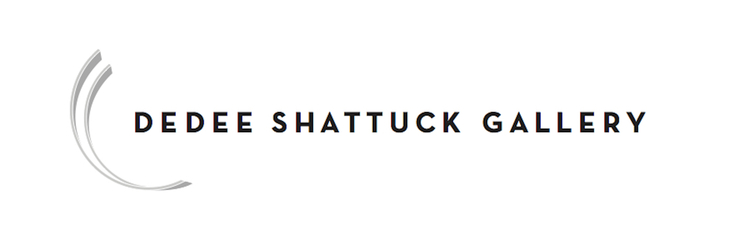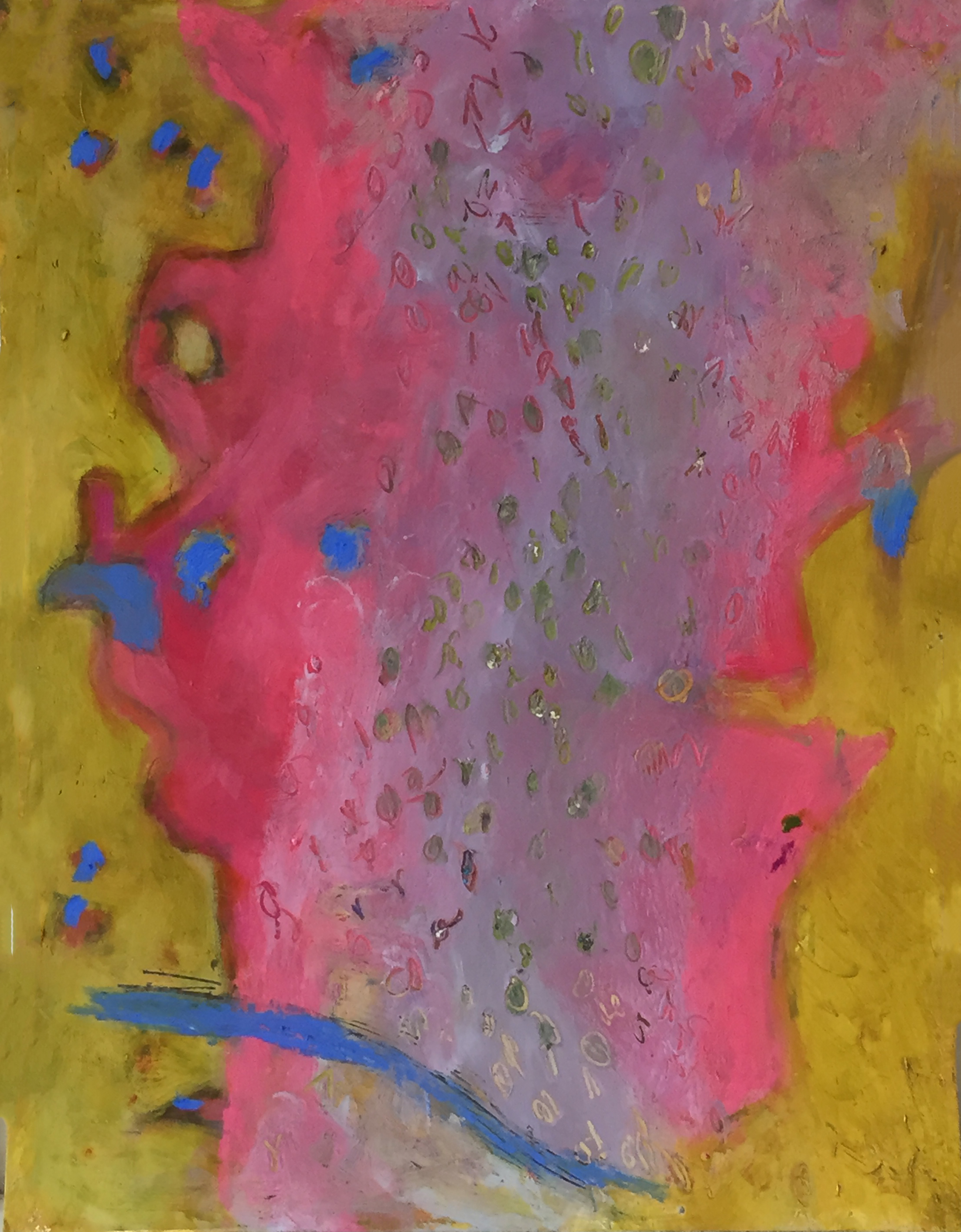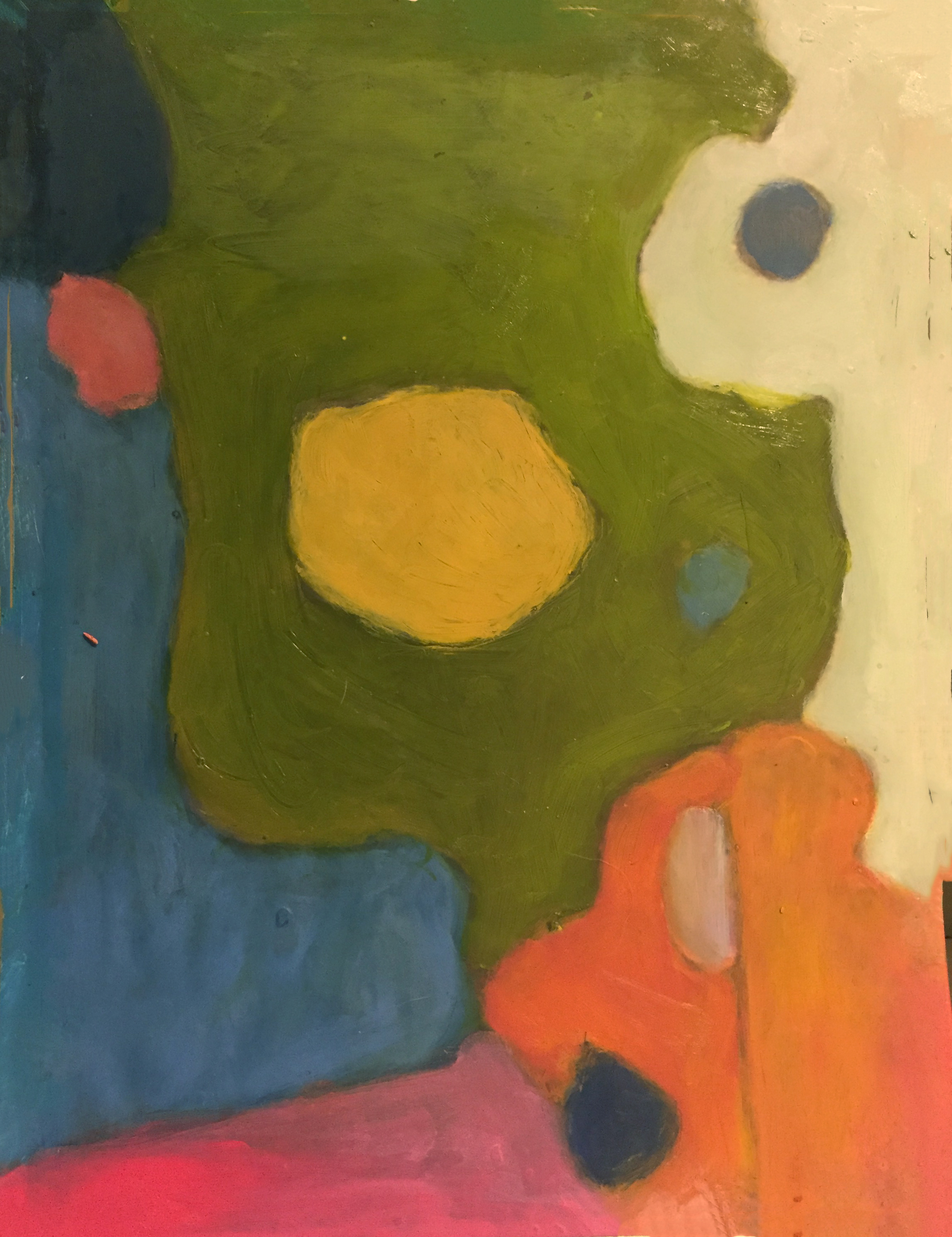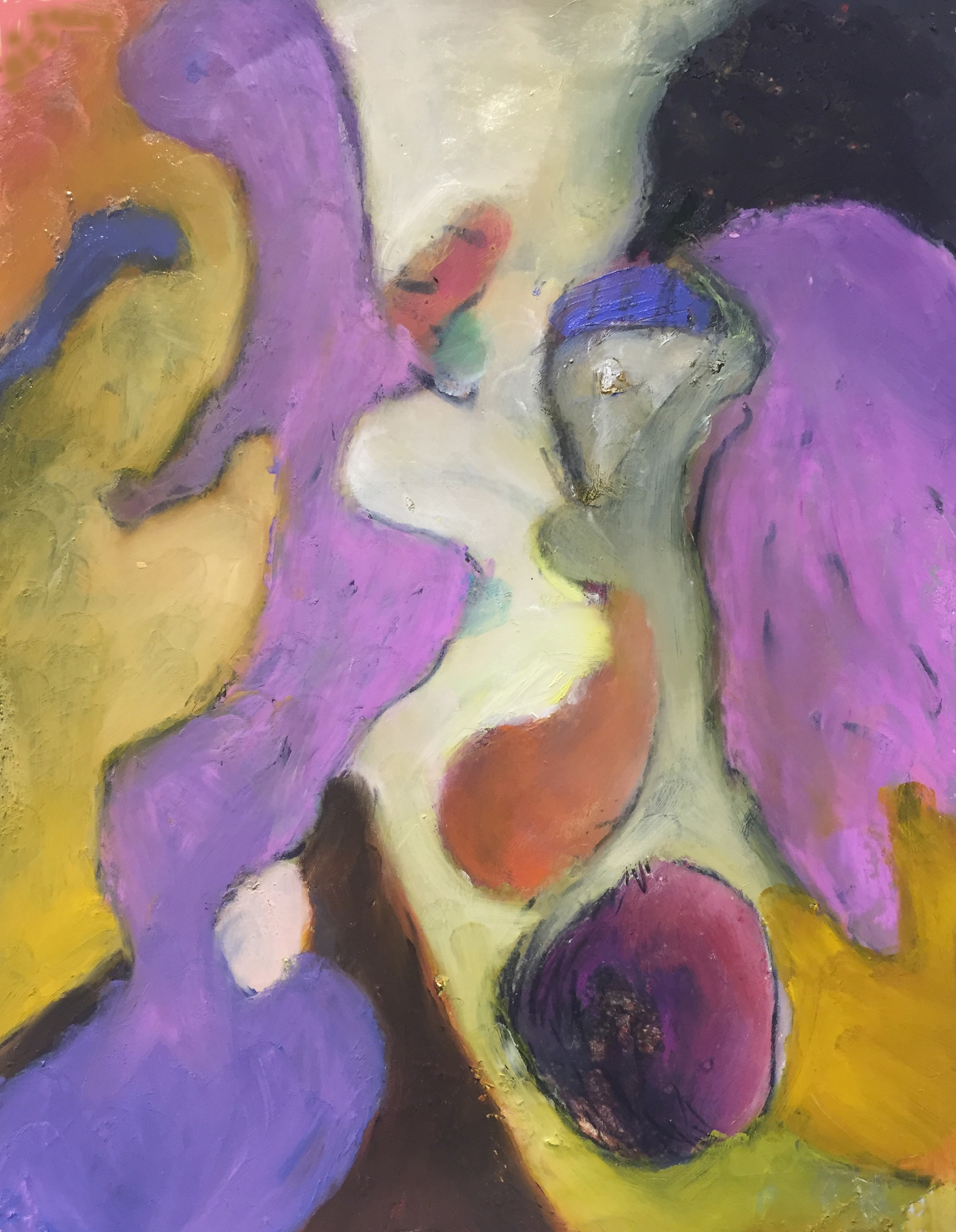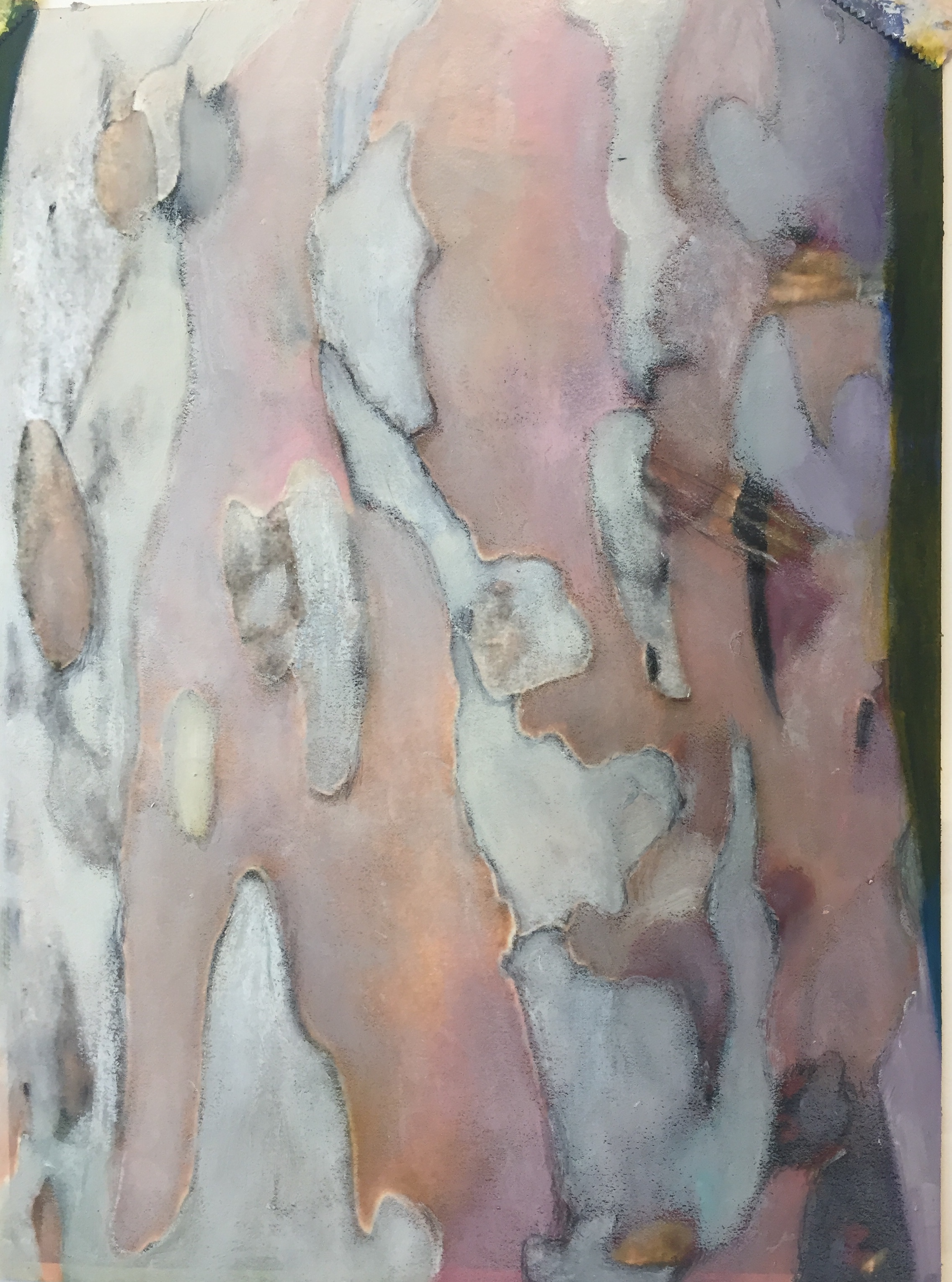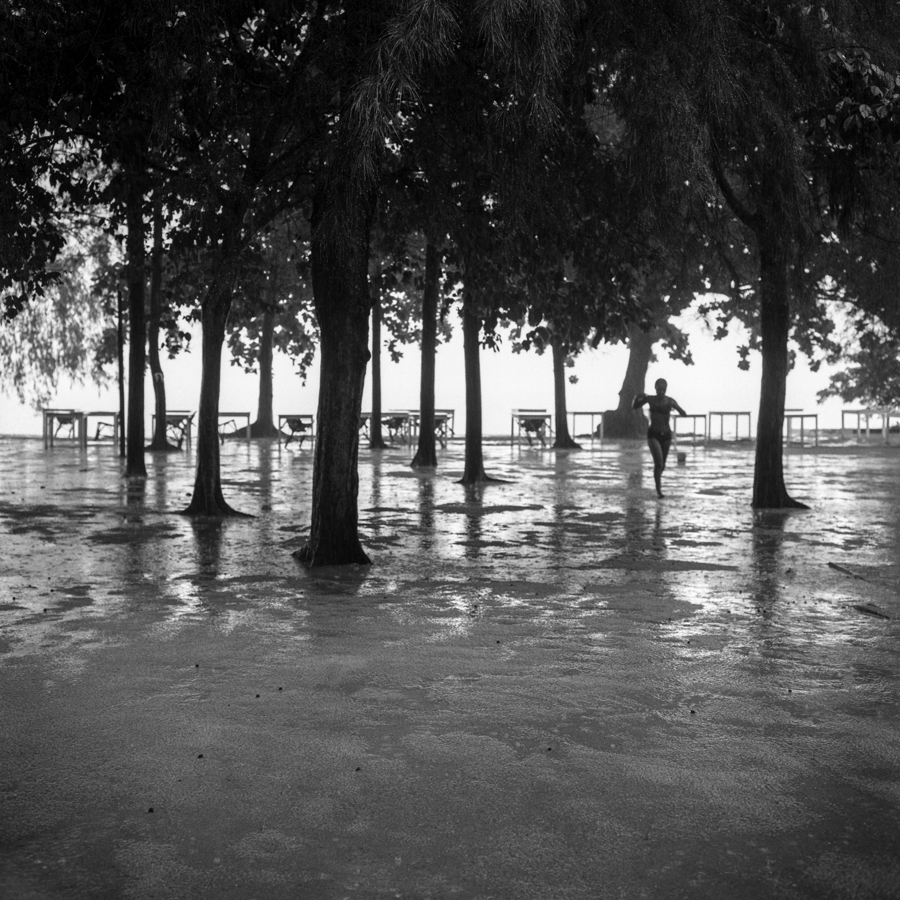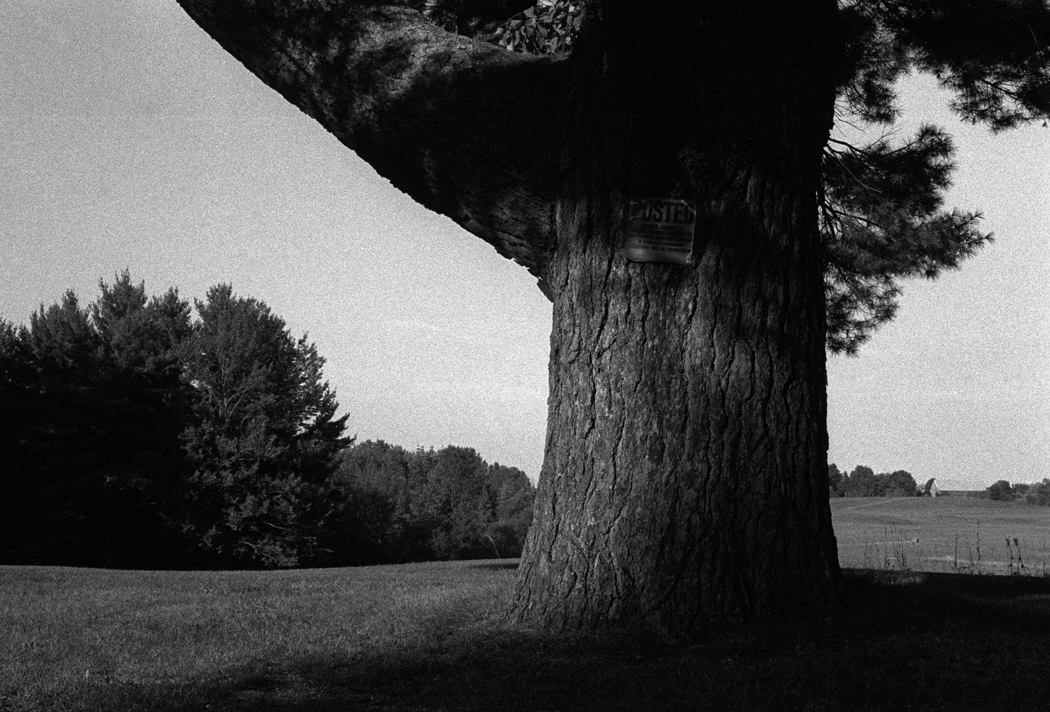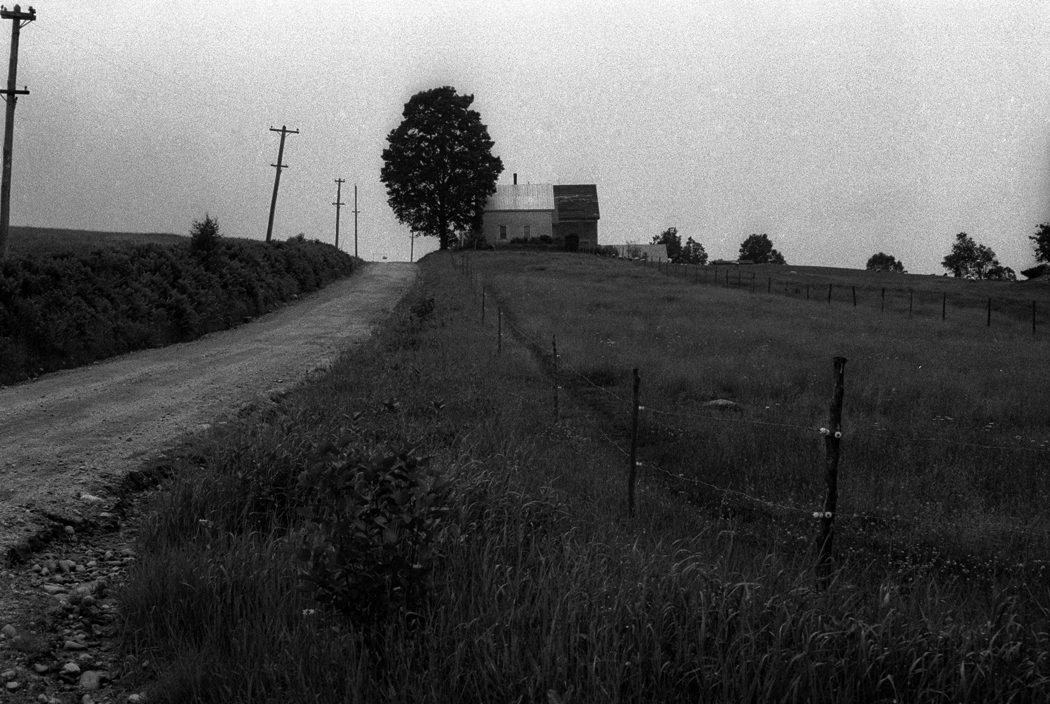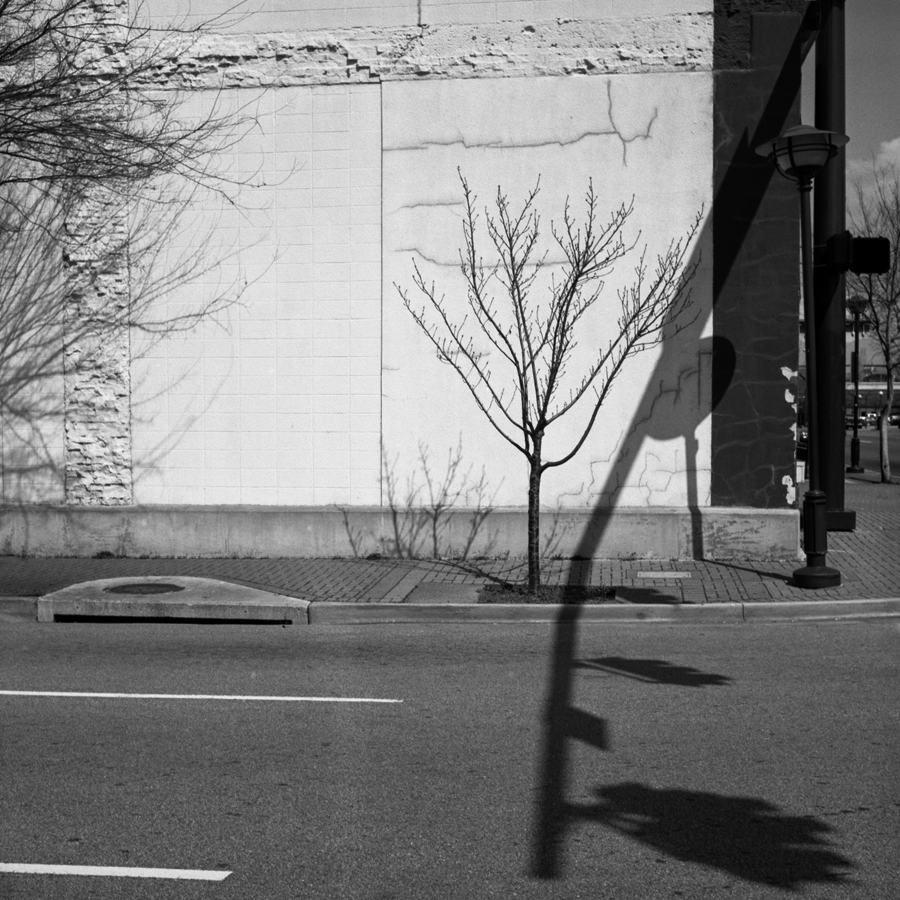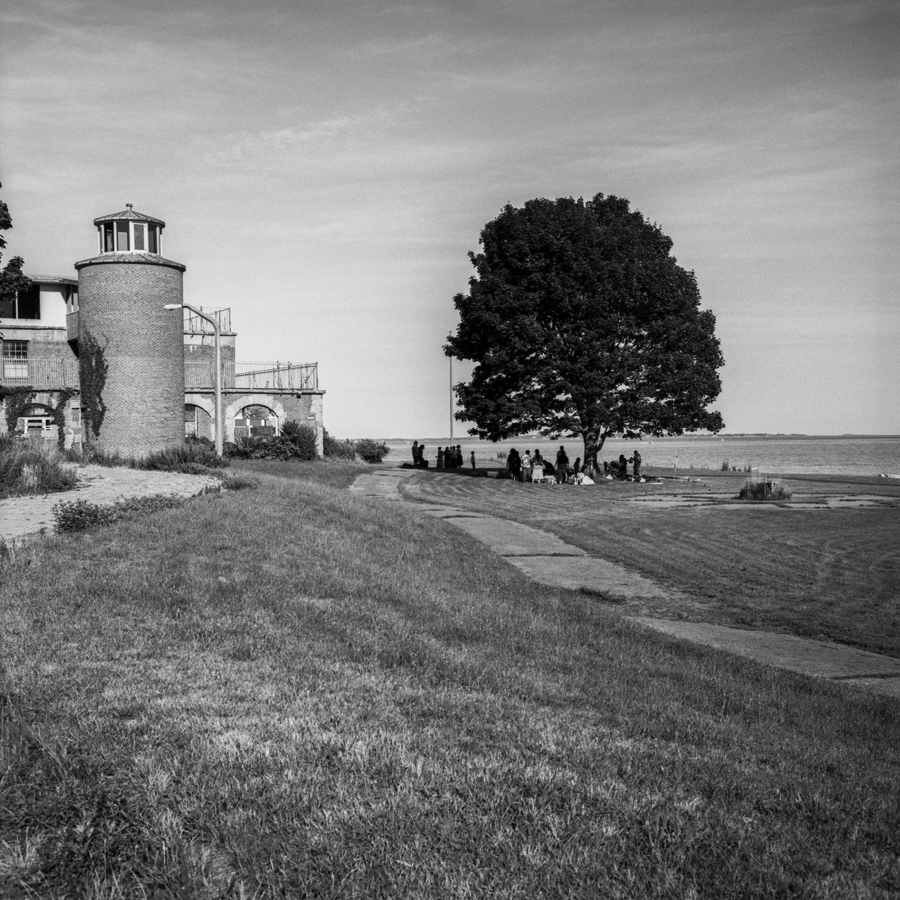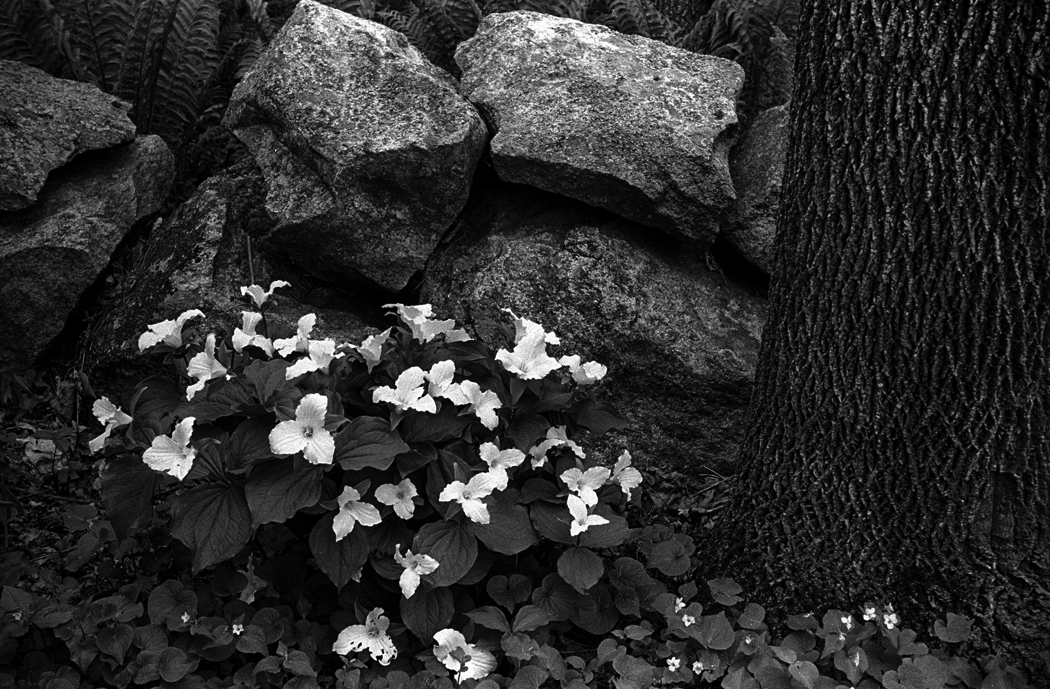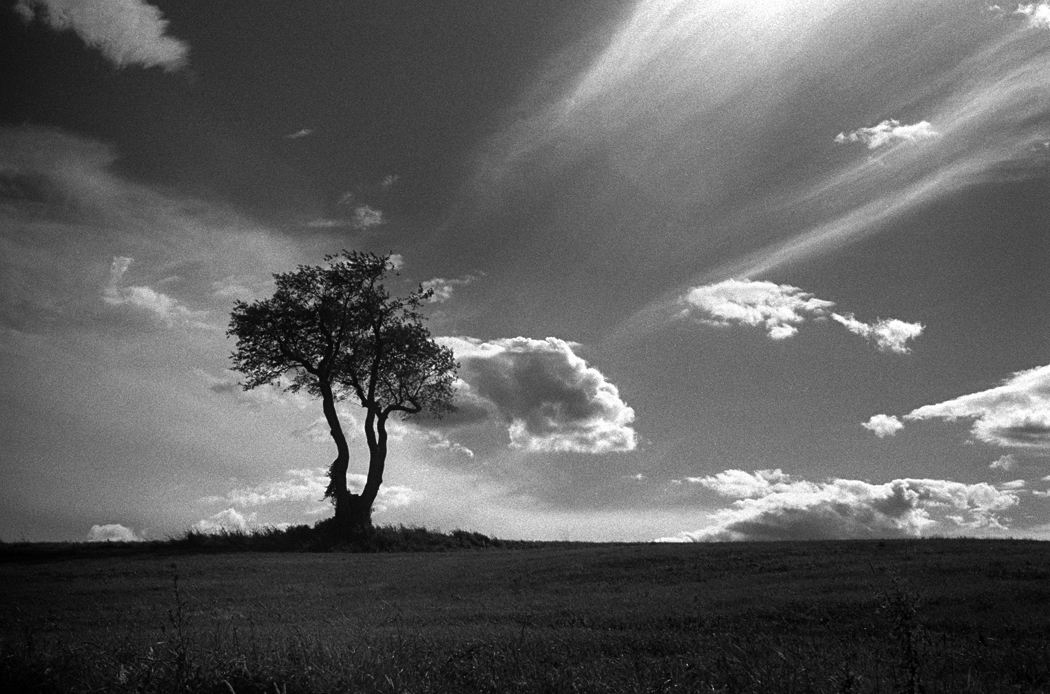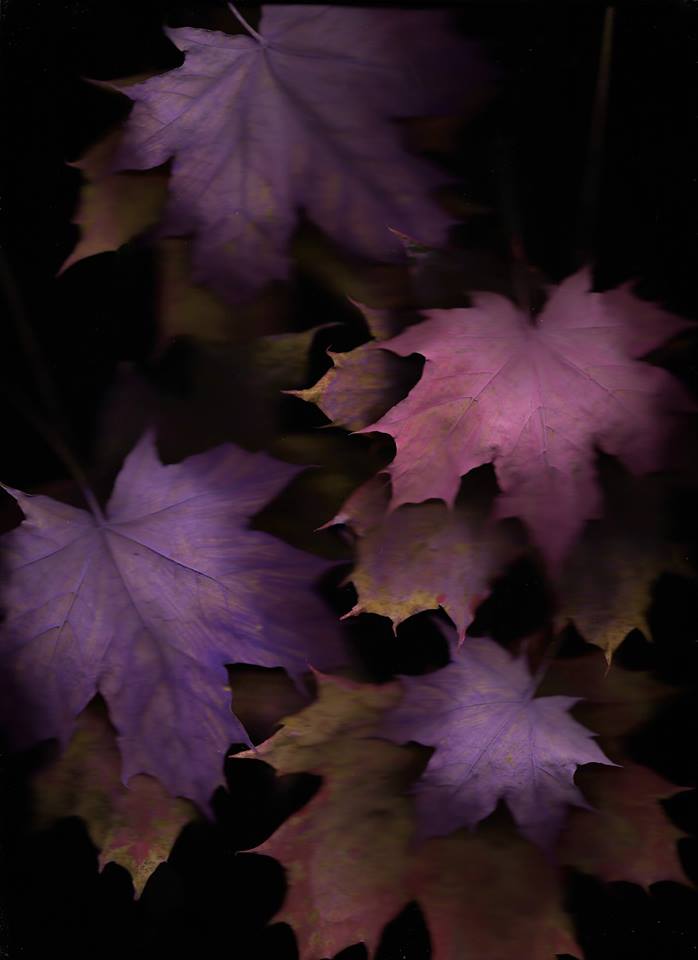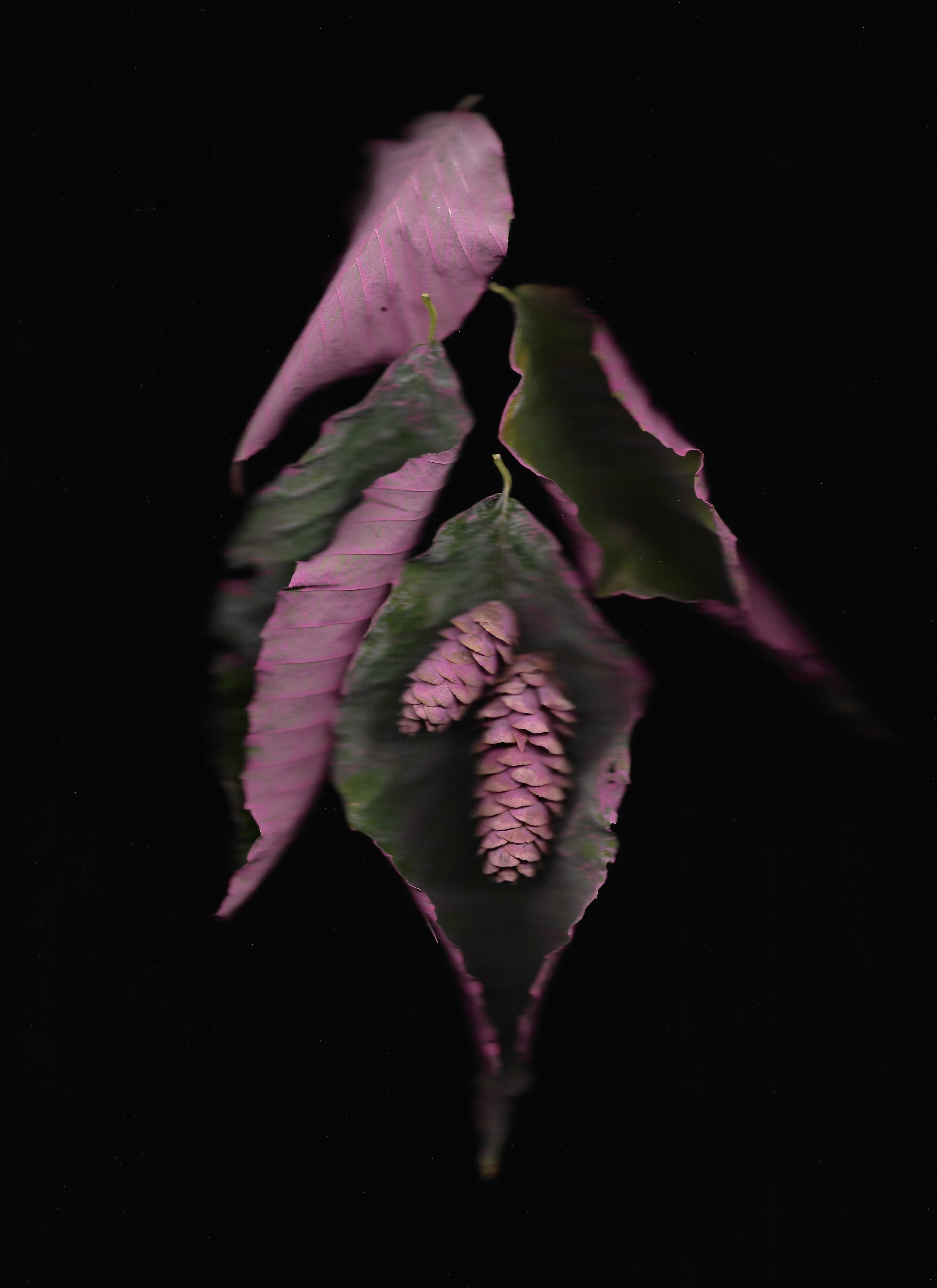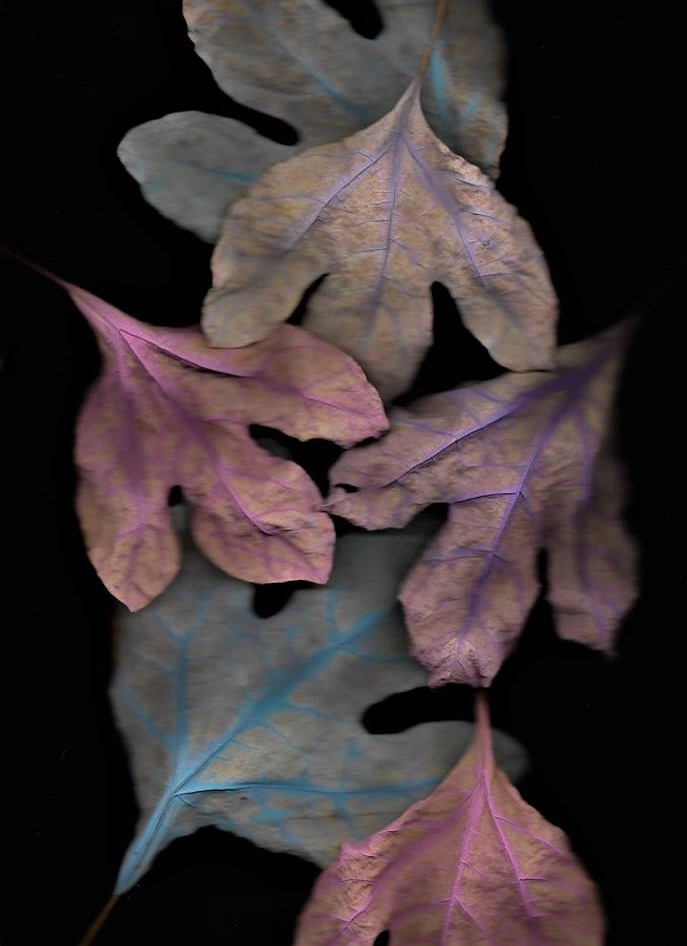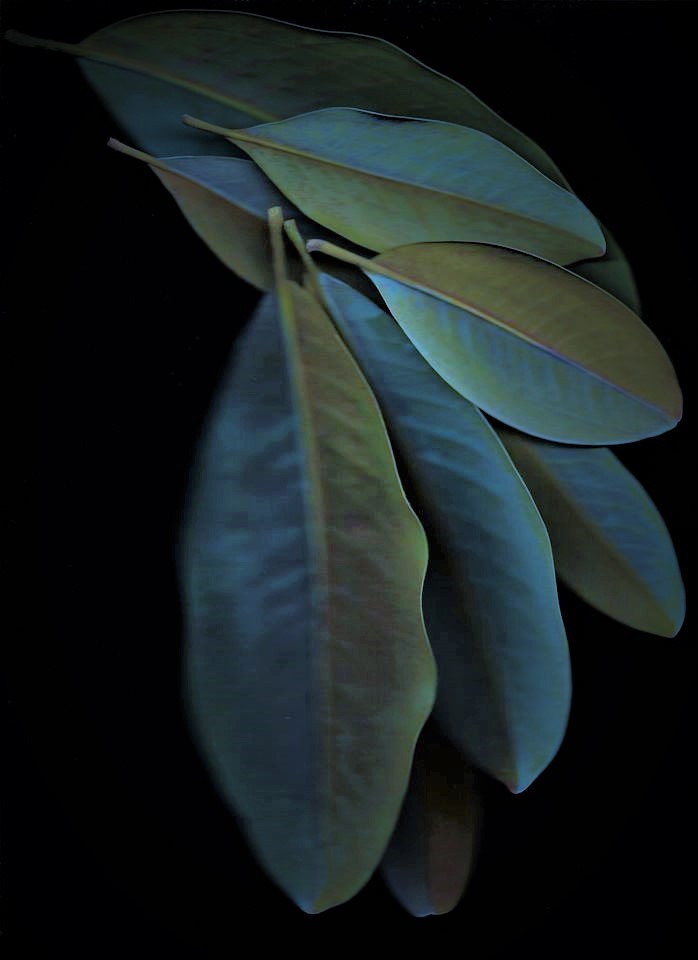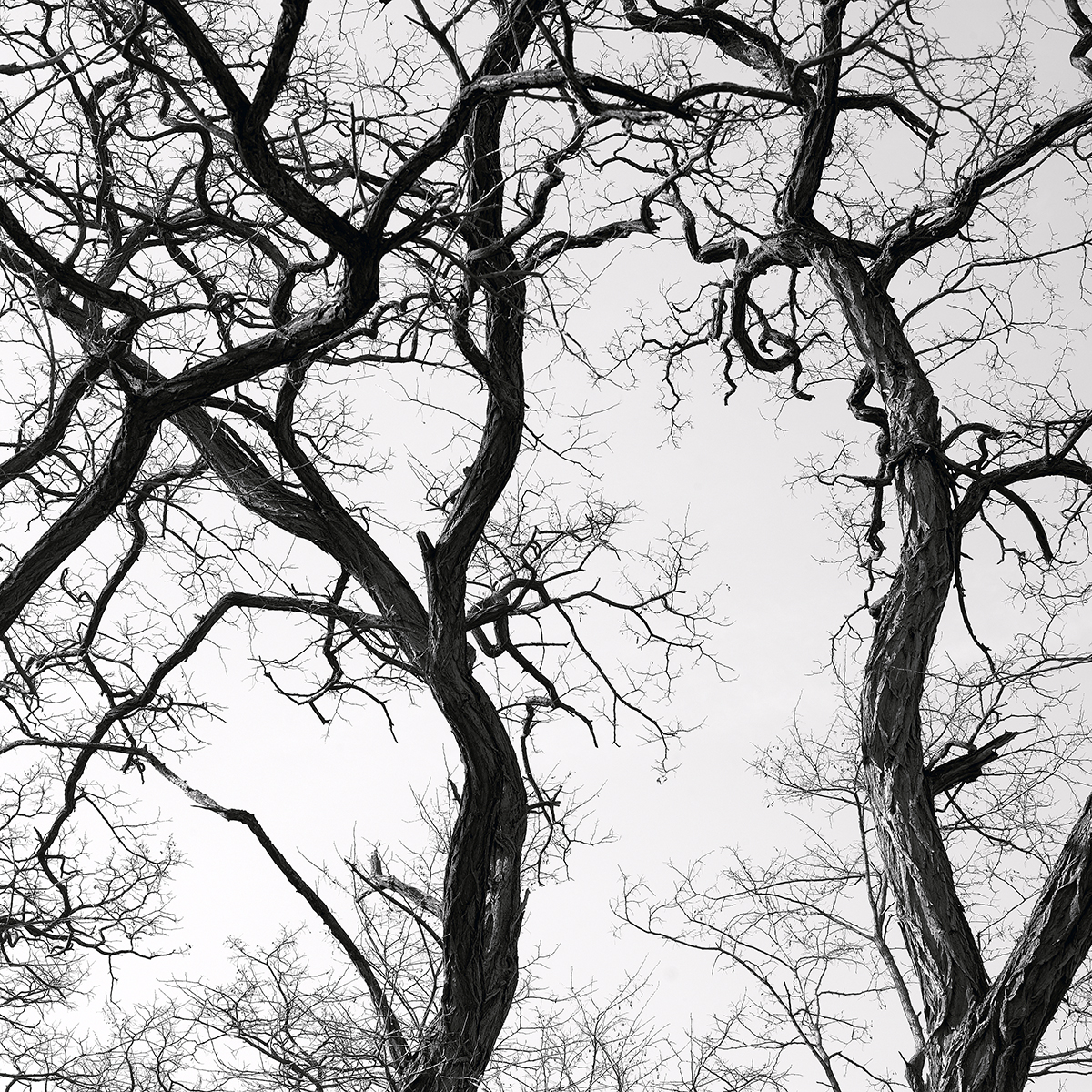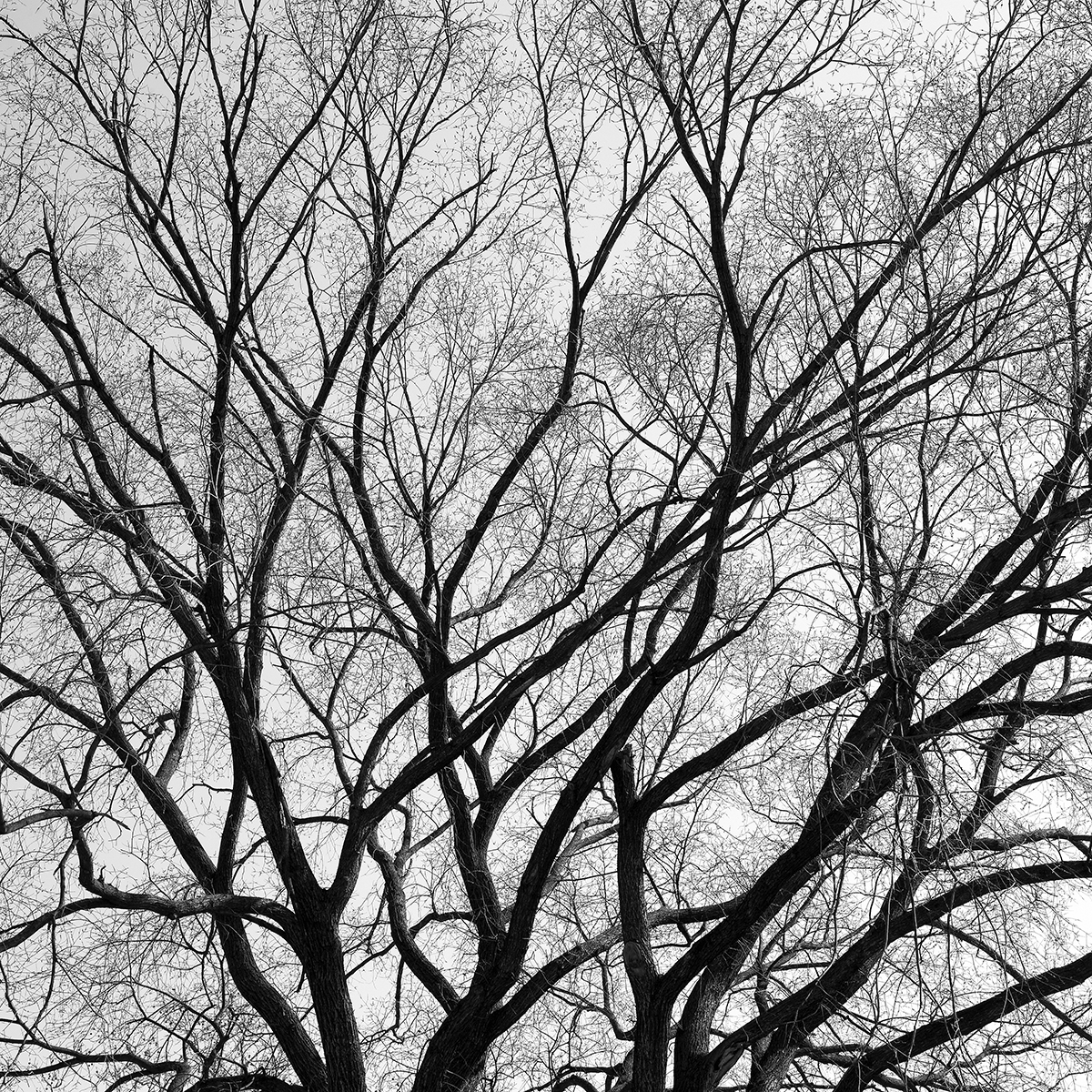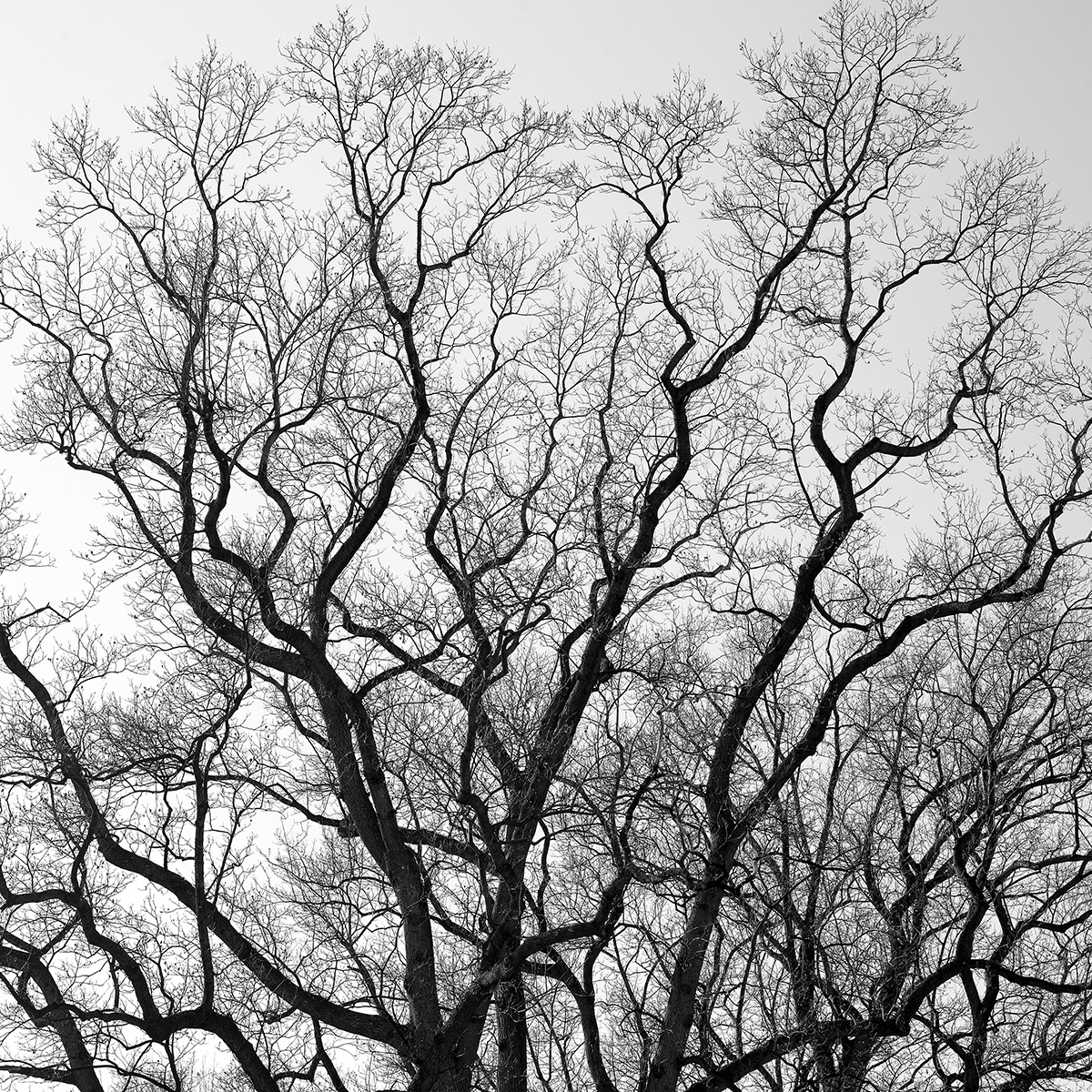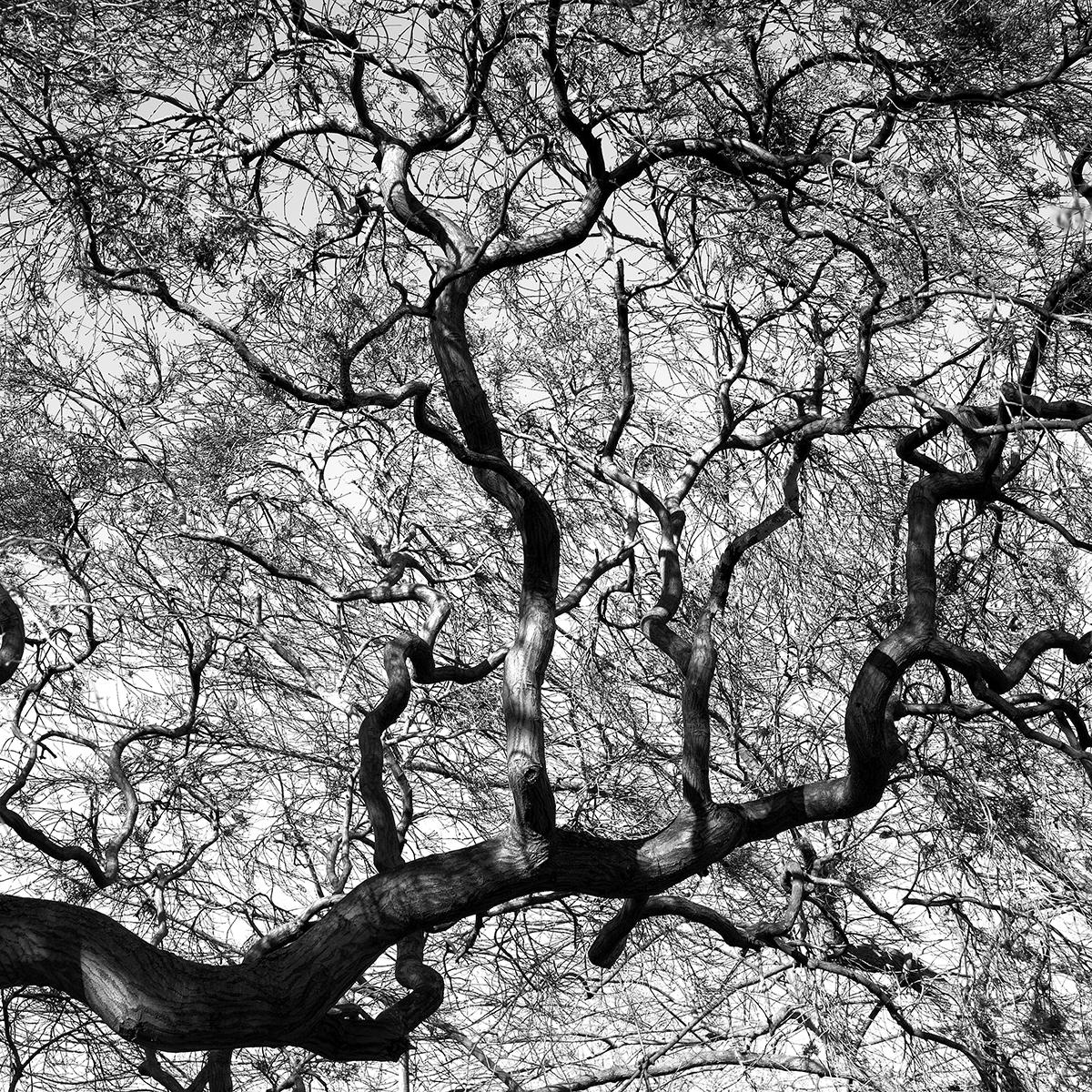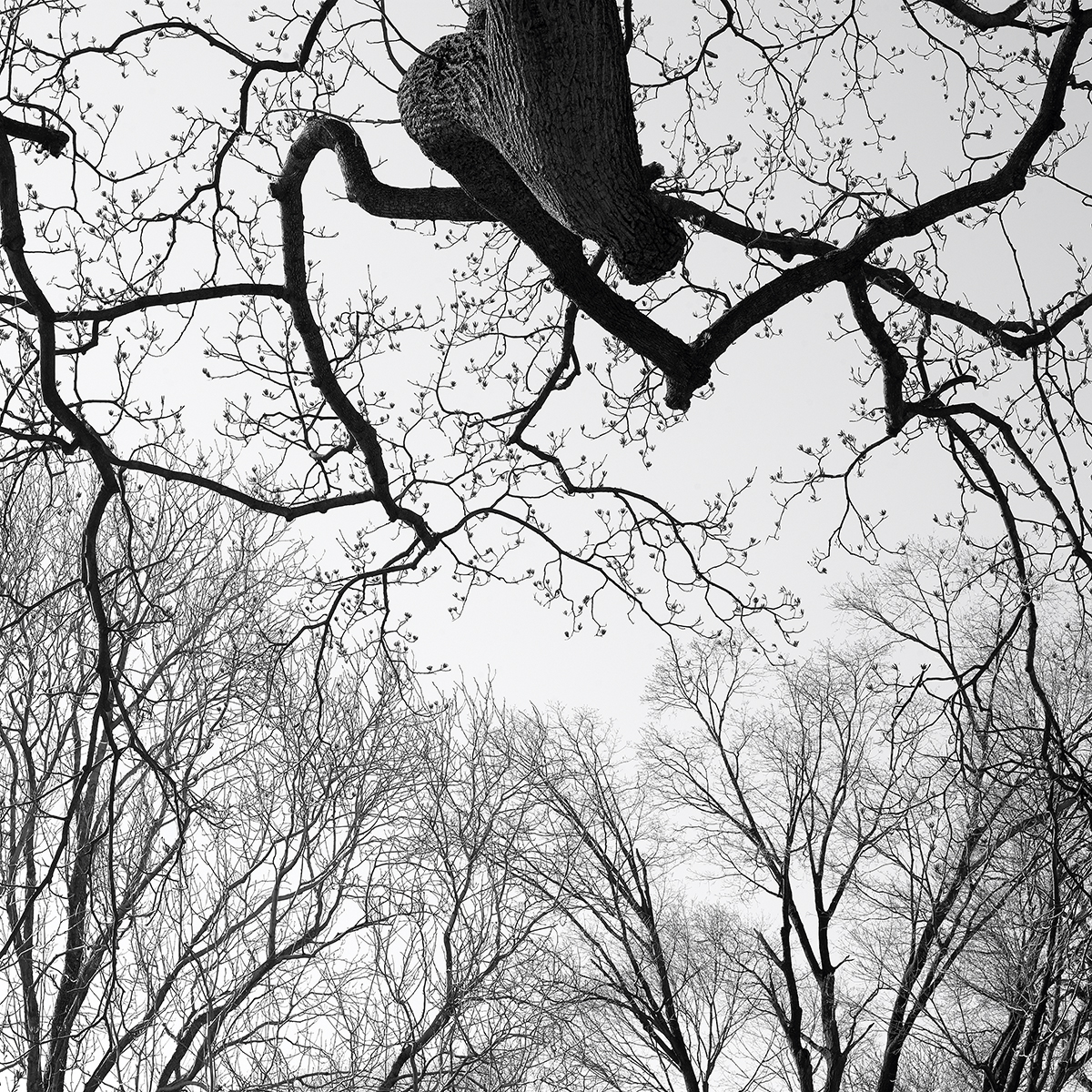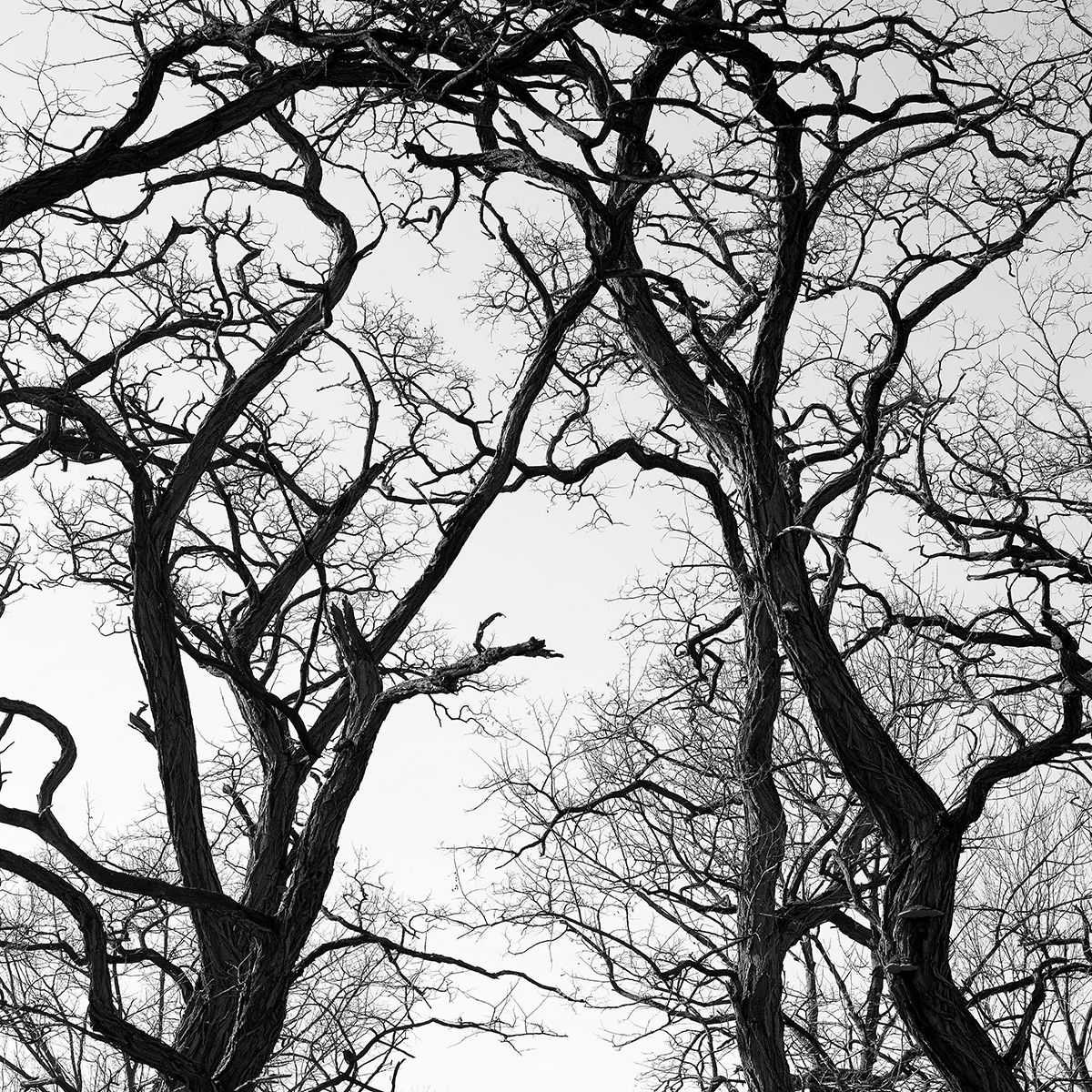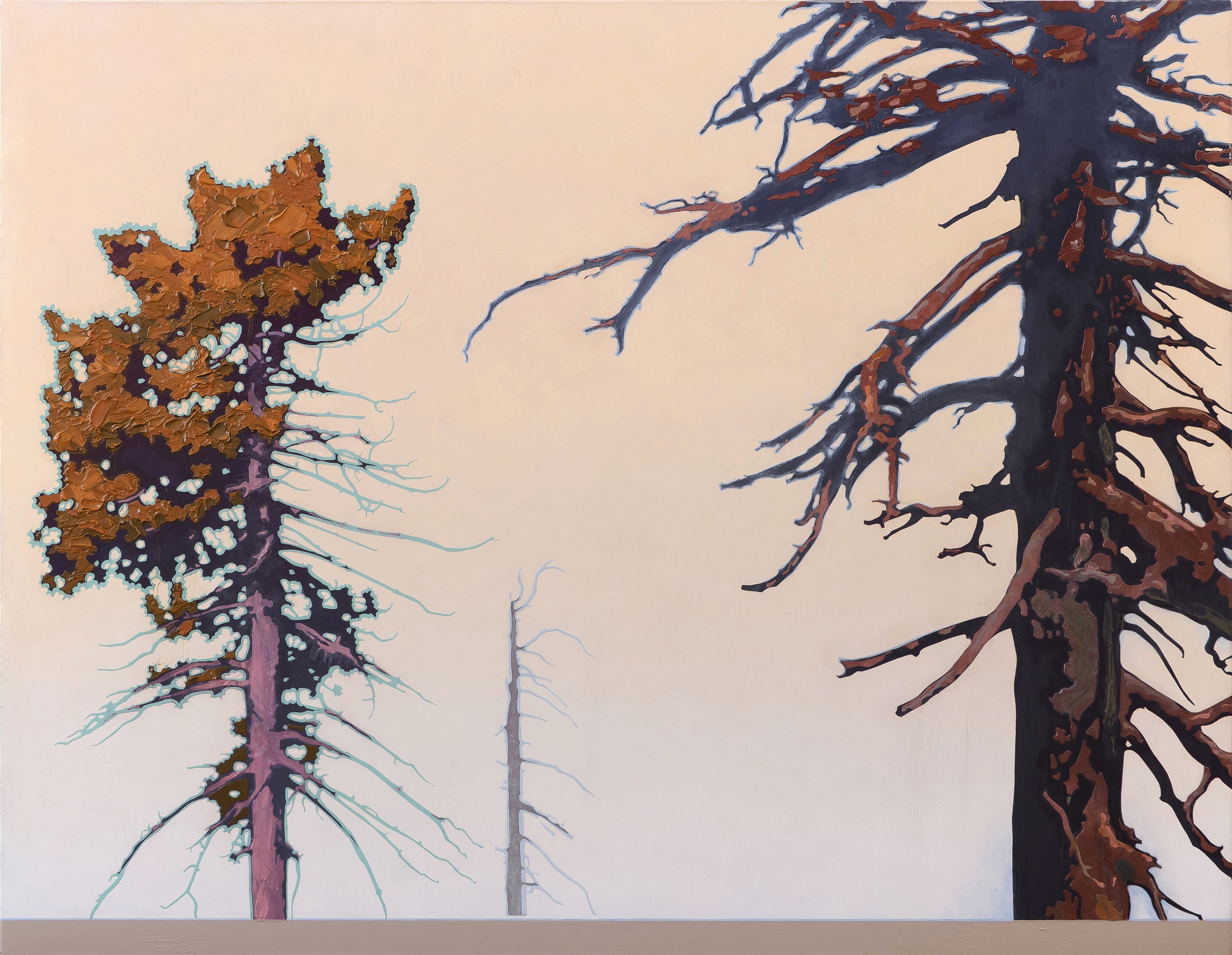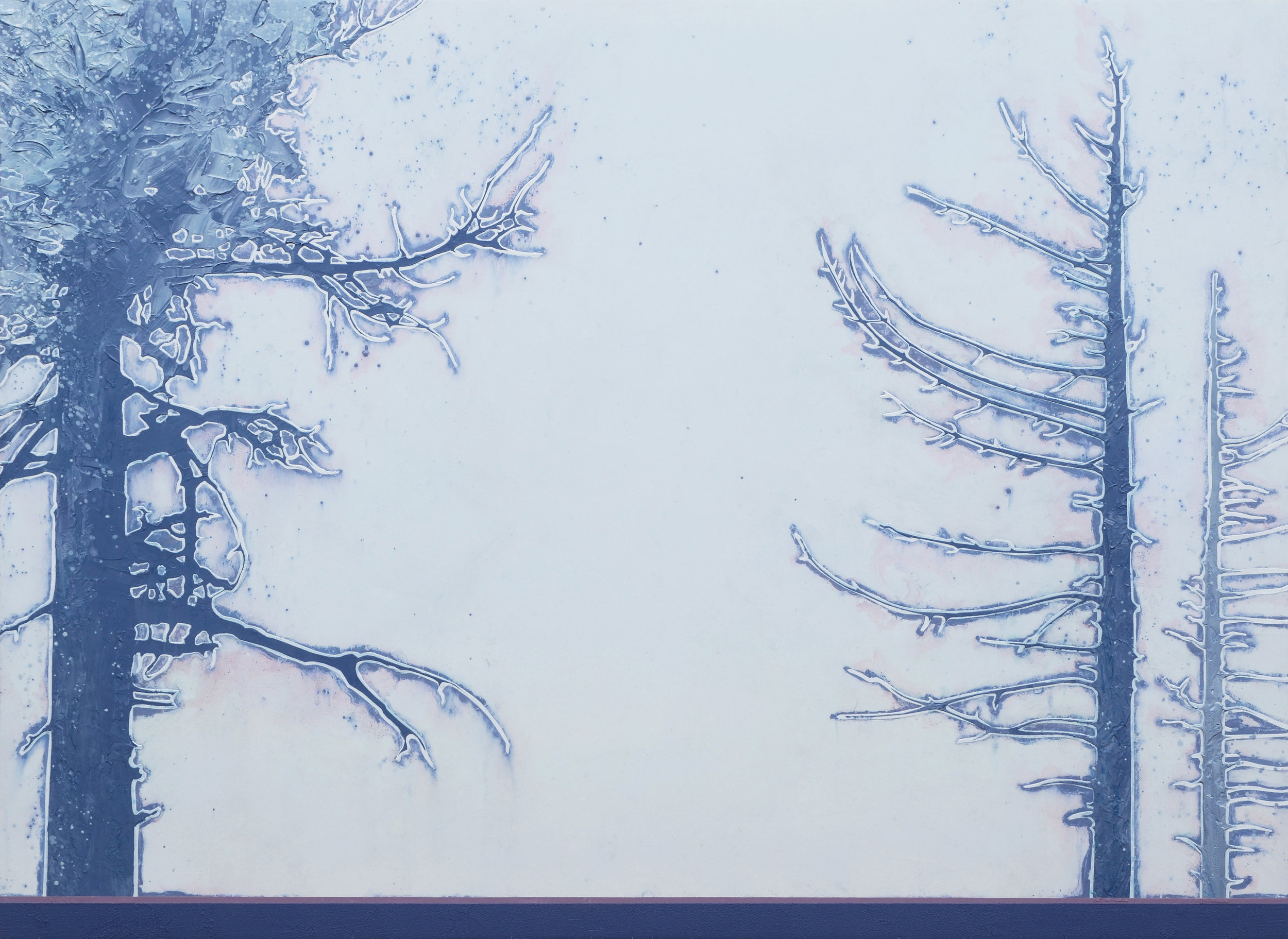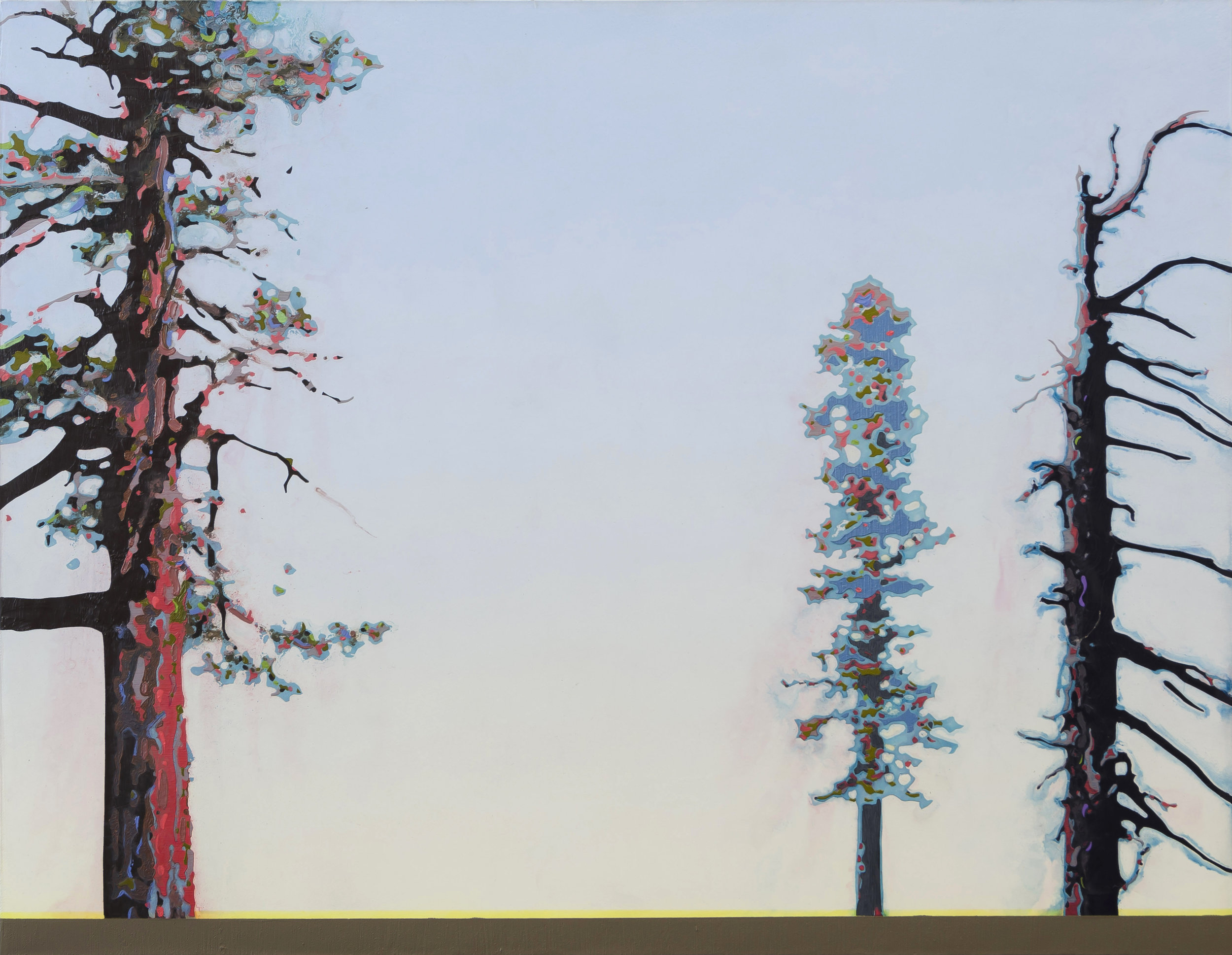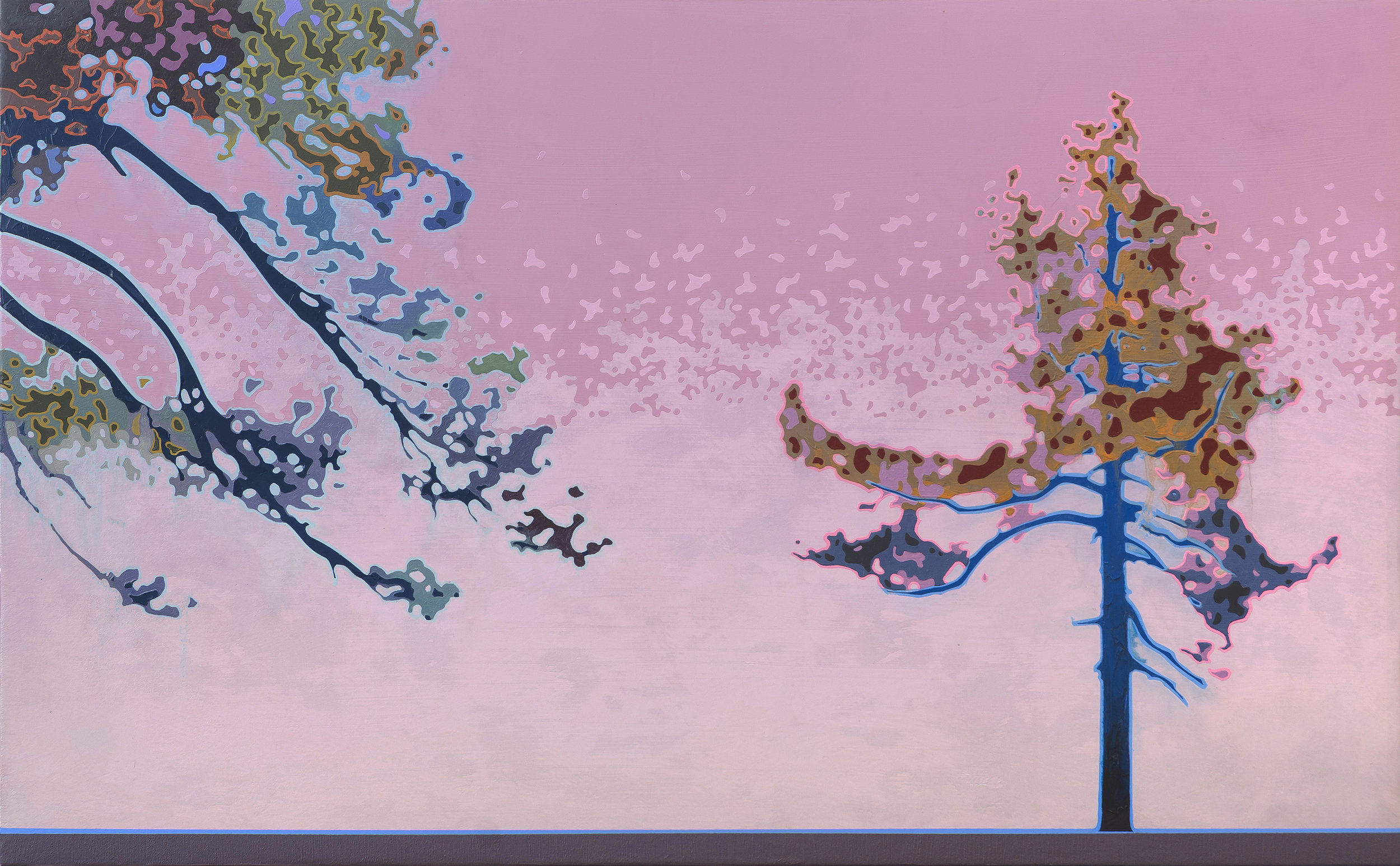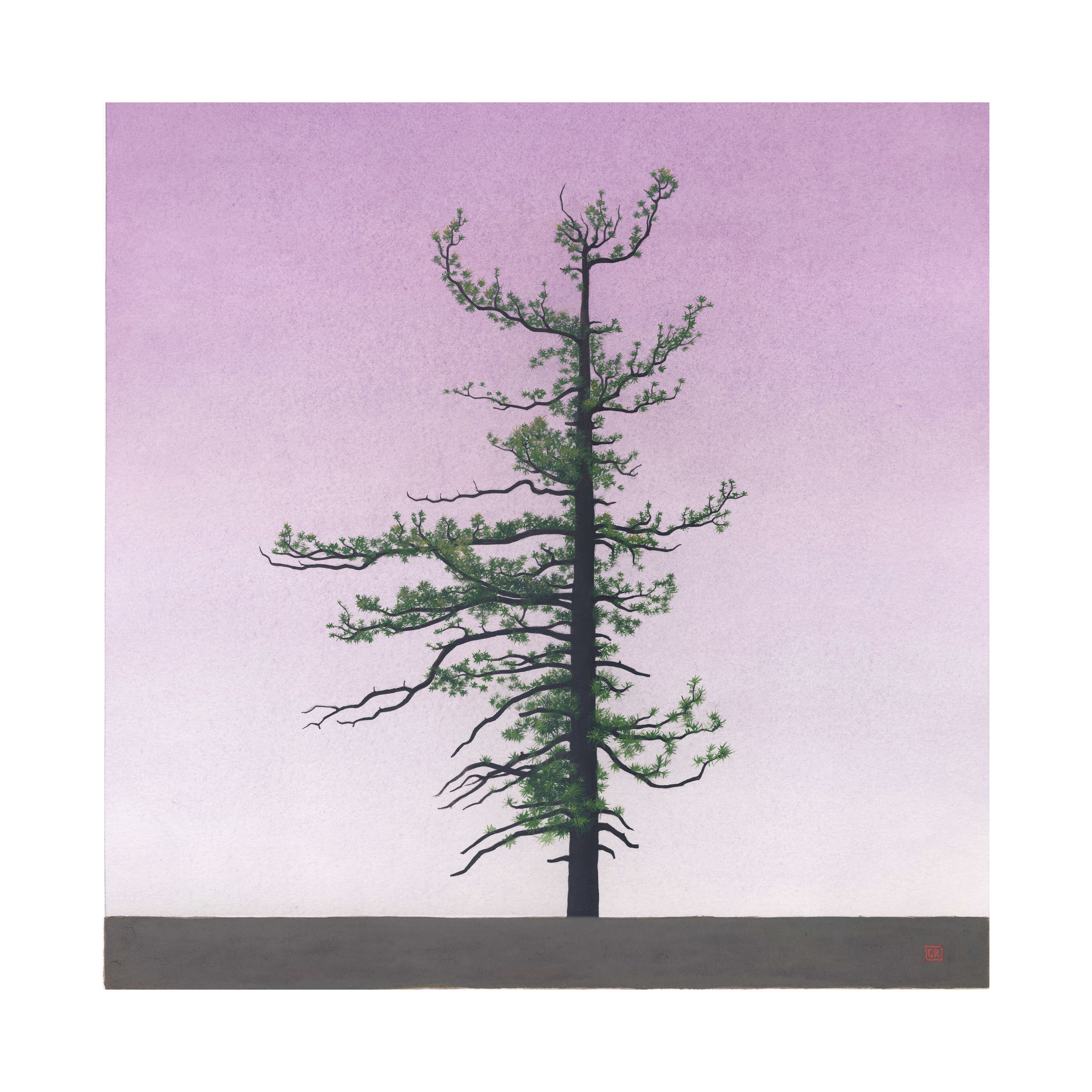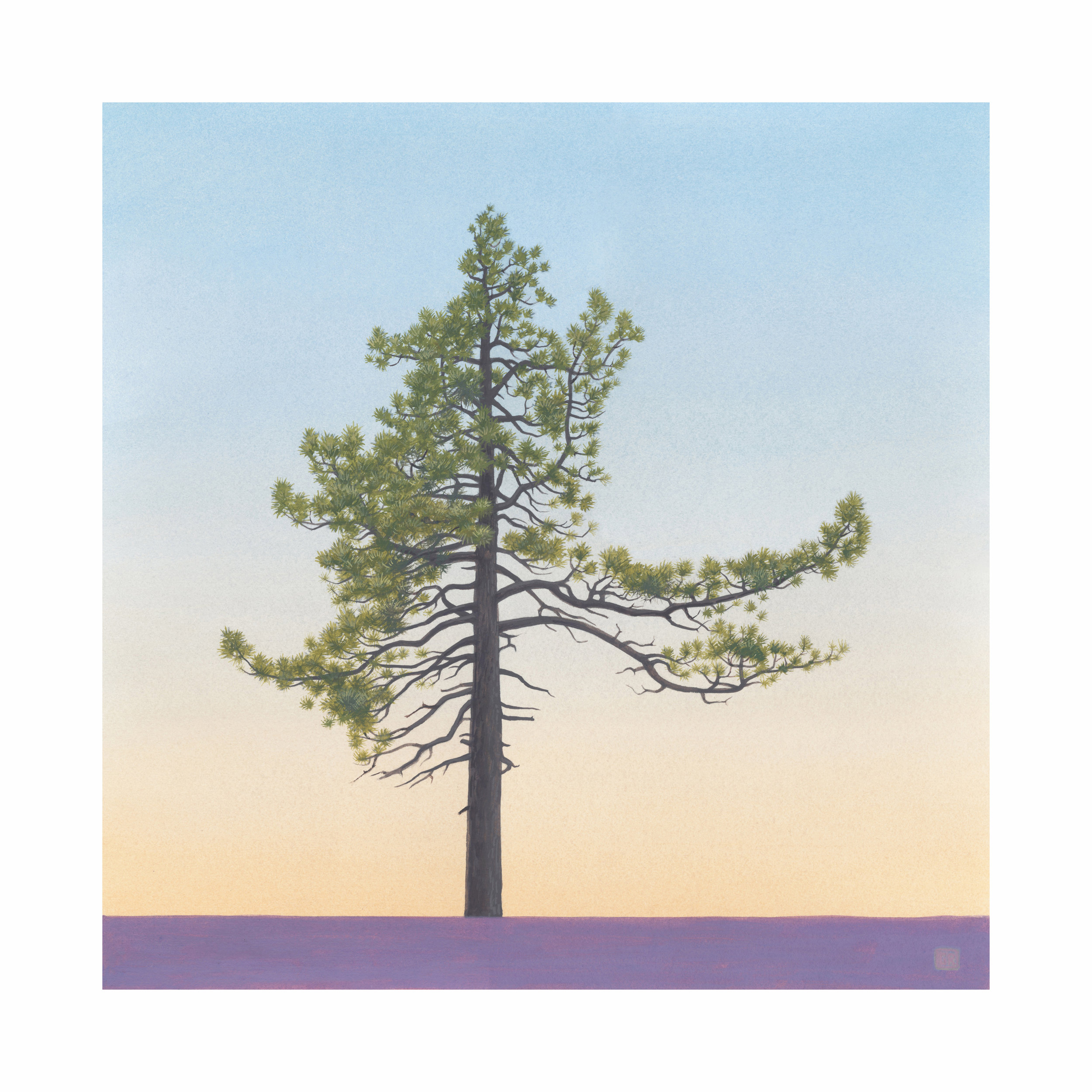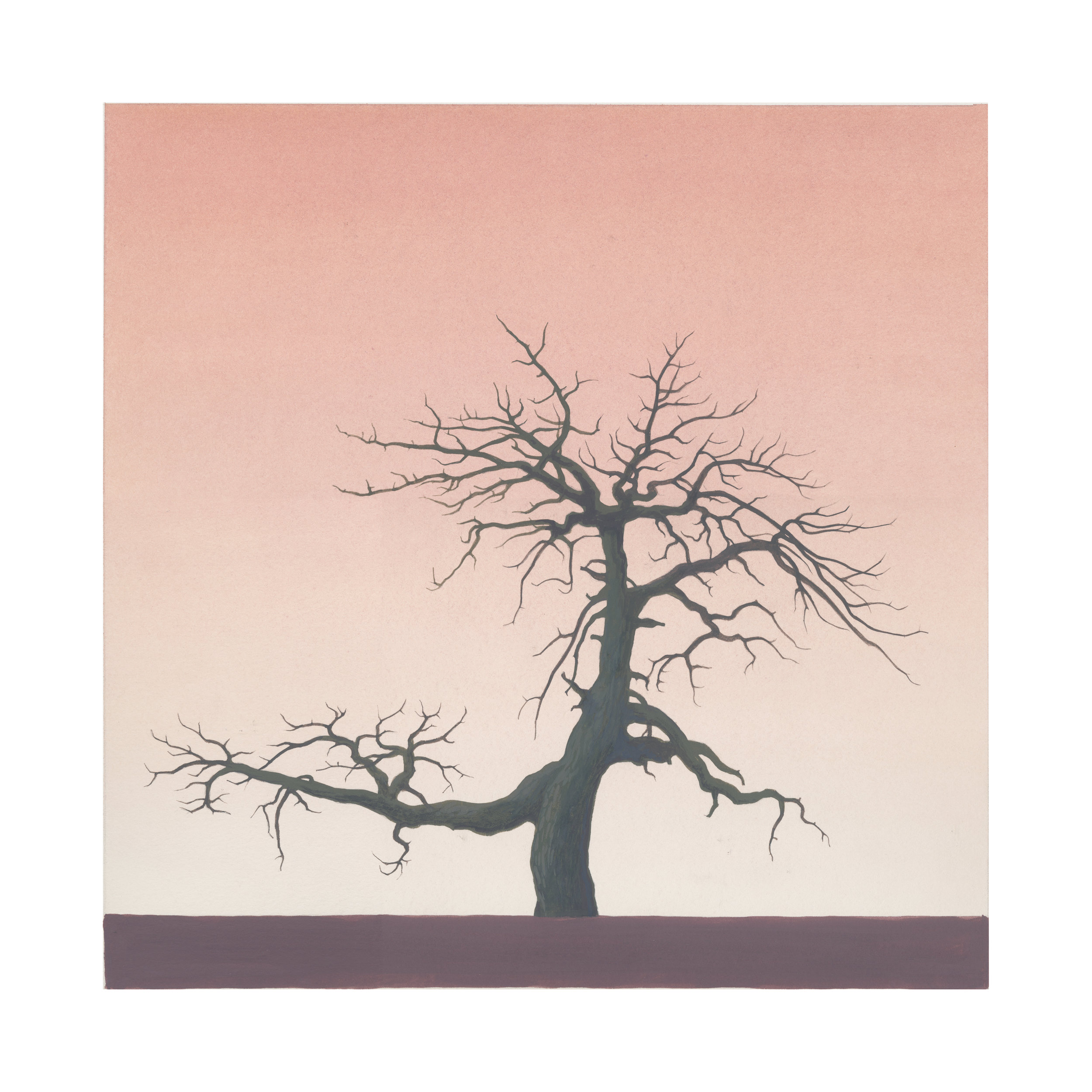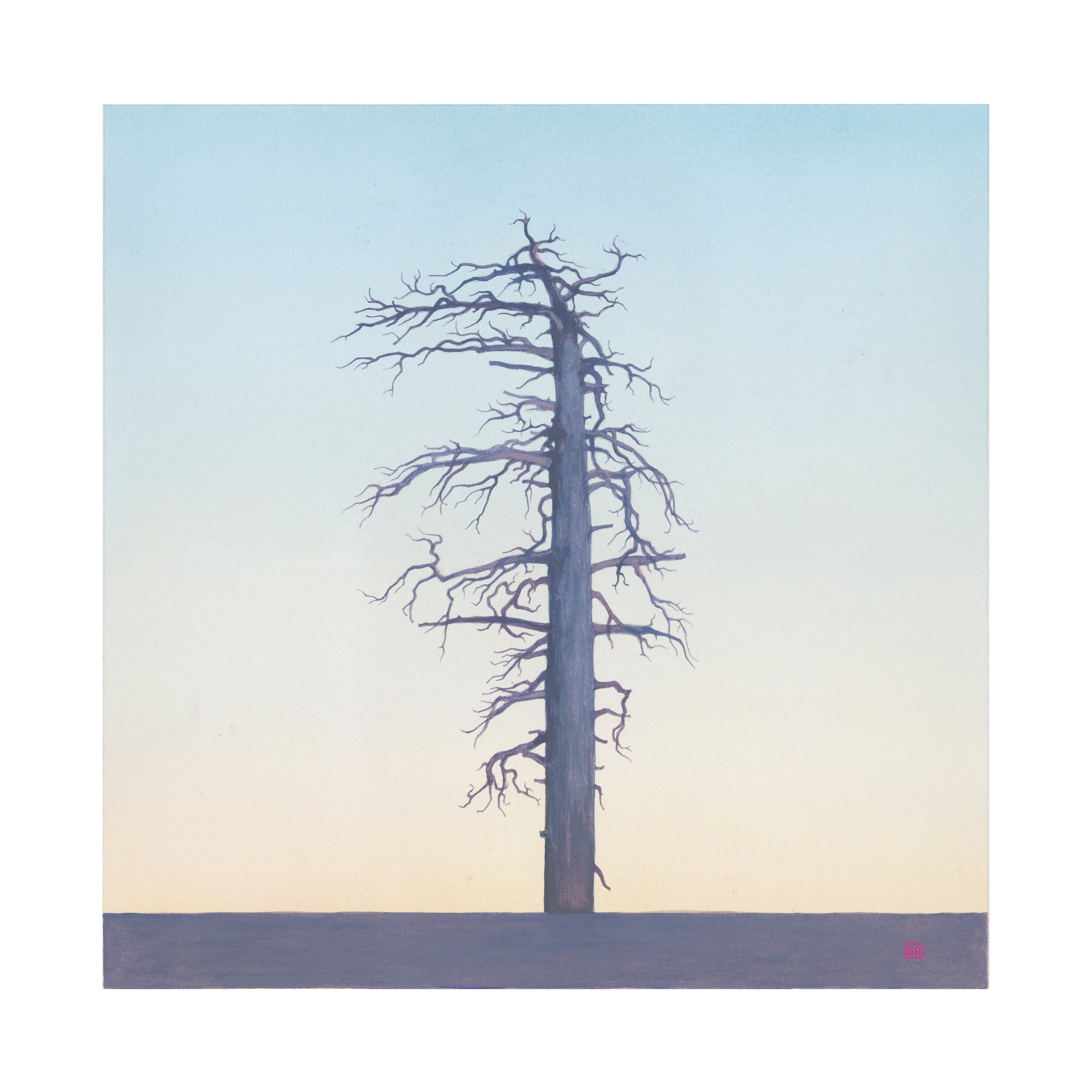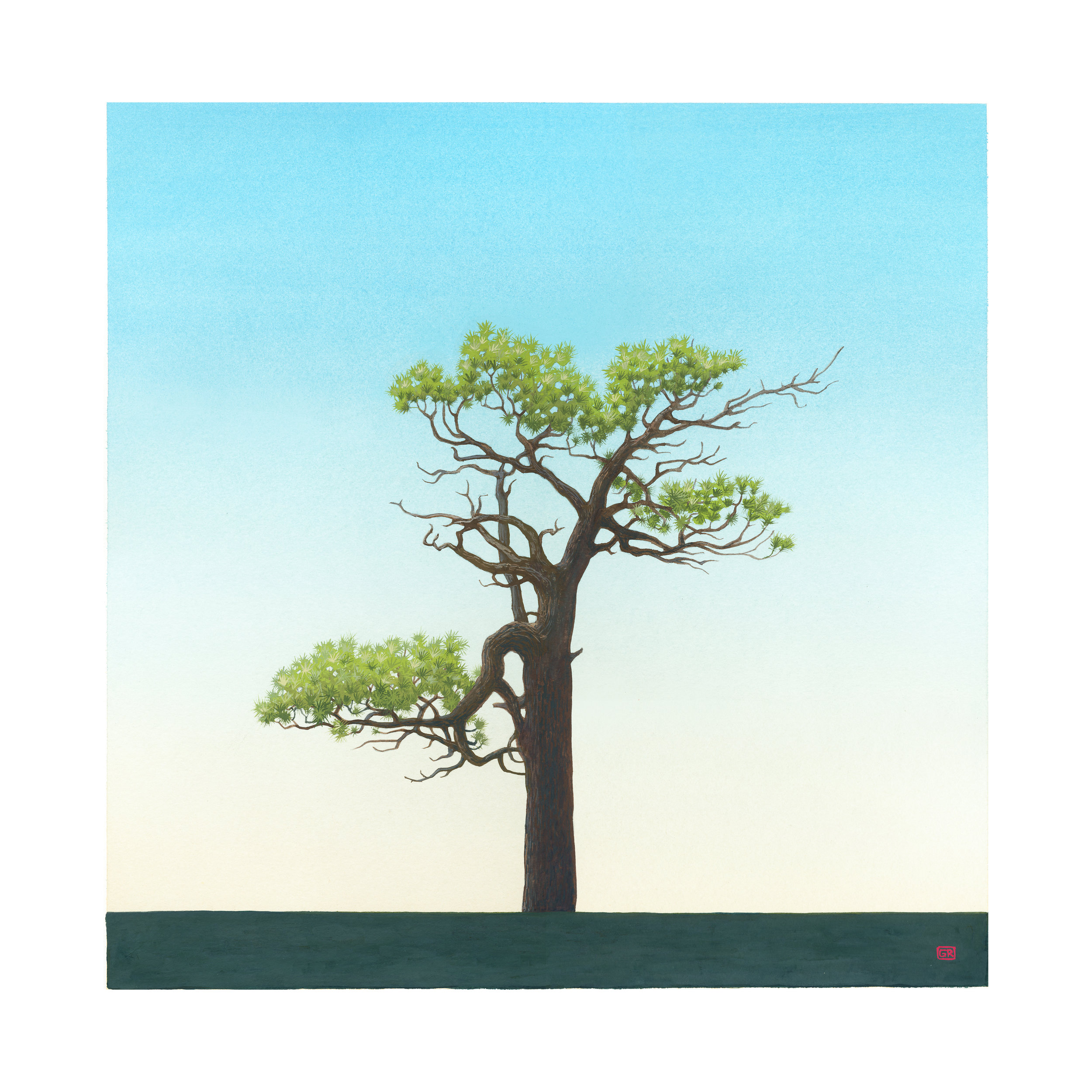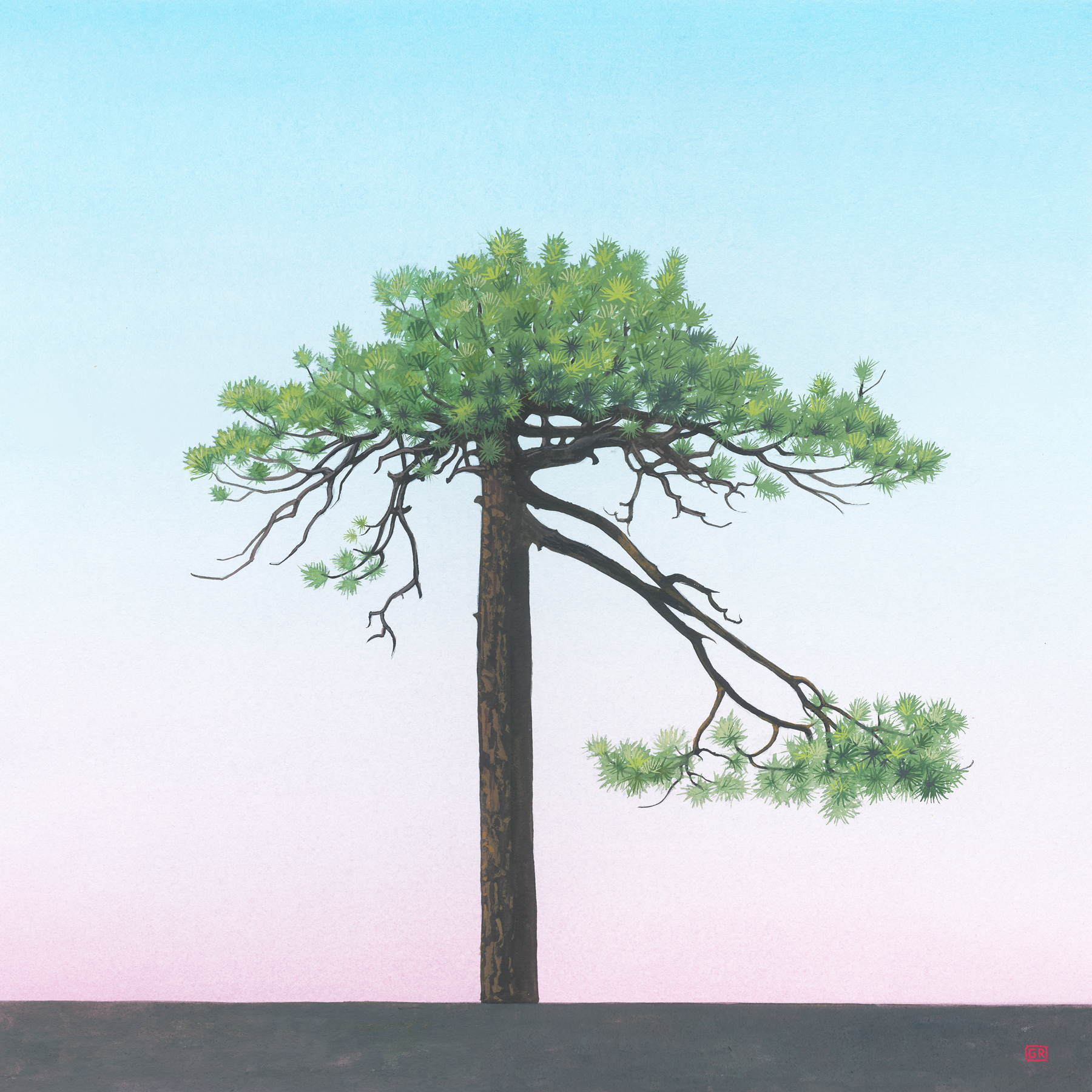June 8 - 30
Opening Reception
Saturday June 8, 5-7pm
We seek solace in the stillness of the forest, or in the strength and resilience of a solitary tree. For millions of years, trees have taken root into the earth and reached high into the sky for sunlight. They symbolize the Universe, creating mythologies and artistic inspiration. We stand in awe of their intrinsic grace, generosity and dignity.
These six artists reveal deep reverence and connection to these sentient and essential life forms.
Greg Rose reminds us that each tree is unique, much like the diversity within a family or individuals within a community.
Deborah Coolidge creates temple rubbings of tree bark, her action revealing the underlying spirit and form of her subject.
Ana Flores says that spending time in Nature is an outlet that feeds her soul, referencing the natural world as a spiritual, inspirational, creative and educational resource.
William Harting seeks within his viewfinder one tree among many. He captures the Divine. Without frames and flush-mounted, he offers the immediacy and intimacy of his photographs with nothing between the viewer and the image.
Renee Monteiro-Bernard uses a scanner bed to photograph natural objects as staged compositions celebrating the beauty and awe of the natural world.
Paul Rider recognizes trees as one of the elemental structures in our world. Their forms, against the sky when one looks up, can be mesmerizing.
Deborah Coolidge
ARTIST STATEMENT
“I frequently tramped eight or ten miles through the deepest snow to keep an appointment with a beech-tree, or a yellow birch, or an old acquaintance among the pines.” Henry David Thoreau
I make appointments with forests to find a tree whose bark jumps out at me. It could be its age, deep furrows, it could be burls or scars, or crotches that diverge. The skin reveals all. These trees have seen so much standing in place. Making a time line of tree and human history matching up events gives new meaning to the slowness of time that the tree lives. The bark records as calligraphic notations the passage of time. Deciphering this language is fascinating. Maps are revealed like braille.
Of all the photographic records I’ve kept of trees, I noticed small compositions of bark incredibly beautiful and vastly different from one species to the next. Using color has been a way to respond and give it an anthropomorphized insight! These small portraits for me begin with bark composition and intuitively look for color to offer expression.
ARTIST STATEMENT
As I look out our bedroom window onto the early spring morning my eyes trace the complex lace of branches that surrounds us. I feel as if my presence here in this house made of wood is a tiny node of a greater mind. Since we moved into this forest almost thirty years ago I have often felt myself absorbed by this larger consciousness. I know that my neurological wiring has changed from living intimately in a place that is still somewhat ecologically whole, with more non humans species than humans sharing the land. Over time I have come to think with the Forest, and the Forest thinks through me.
My intuitive knowing has been corroborated by scientific data. A forest ecologist from British Columbia, Suzanne Simard, recently tracked the networks of roots in forests. Underground the roots are connected by a far reaching and dense web of mycorrhizal fungi. The fungi allow the roots to exchange information warning of insect attacks, wind storms, and also delivering resources: carbon, nitrogen, and water to trees in need. This communication and co-operative resiliency building that goes on interspecies functions like a giant neural network- that greater mind of which I am just one small node.
BIOGRAPHY
www.earthinform.com
Ana Flores is a sculptor, ecological designer, educator, curator, and activist. Her sculptural work focusing on cultural and ecological narratives is shown internationally and included in private, corporate and institutional collections throughout the United States and abroad. For over two decades she has been promoting interdisciplinary dialogue and groundbreaking collaborations between the arts and sciences. She has worked with communities to design award-winning outdoor installations, parks, and programming that engage people with the history of their local landscapes and the landscapes they carry within- as cultural heritage. Flores interest with deep ecology and histories of place is rooted in her own experiences of displacement, she was born in Cuba and arrived with her family in the United States as refugees. She now lives and has her studio in Charlestown, Rhode Island, surrounded by forest that is ancient Narragansett land.
As an educator, Flores has been teaching courses on Ecological Art and Designt at Bryant University,Smithfield for over a decade and has also taught the course at Rhode Island School of Design. At the Rhode Island School of Design, she was co-creator of the first course on Arts and Healing and formed an arts partnership called Manos that did many commissions and workshops in Healthcare settings. Flores has been a visiting artist and lecturer in institutions across the United States and abroad. In 2018 year she was the first Schumann Fellow in Environmental Art for the University of New Haven’s Lyme Academy School of Fine Art.
William Harting
ARTIST STATEMENT
As a photographer I have always been drawn to trees, their majesty, their solitary station, their strength. Within the camera's finder I choose one from among many and capture it.
Sometimes the chosen tree will fill the frame. Sometimes it stands alone. It can be anywhere, it may be planted on an urban sidewalk or mark the edge of a farmers' field or dwell in a thicket; it may be youthful and smooth or old and weary. Trees are everywhere. They may even be a nuisance for some, but for me they are divine.
As I look through my camera I imagine the finished product, which will be a black and white print. Framed by the viewfinder, with a click the subject is committed to film and to the longer process to extract the print from the negative.
And finally the finished product. I have chosen to present these prints without a frame, flush mounted, without even a border, just the image itself: the immediacy of a photograph with nothing between the viewer and the image.
BIOGRAPHY
During his work as a writer and editor, Harting made his way to the camera as a comfortable accessory for the pen. Working in publishing with photographers he soon understood the need to complete his seeing in a darkroom. The discipline and limitations of film photography continue to concentrate his vision. The results have been included in publications and exhibits, including two one-person shows in recent years.
Renee Monteiro-Bernard
ARTIST STATEMENT
“I am the vine. You are the branches. He who remains in me, and I in him, the same bears much fruit, for apart from me you can do nothing.”
— John 15:5
maker & Creator
inspire, enlighten, restore...
Finding a path in life that brings you joy and leaves you at peace is a blessing. Spending time in nature is an outlet that feeds my soul as an artist, a designer, a teacher, and a Mom. Each of these roles that I play in life is enriched by referencing the natural world as a spiritual, inspirational, creative, and educational resource.
Renee Monteiro-Bernard’s work revolves around the techniques of using a scanner bed to photograph natural objects as staged compositions celebrating the beauty and awe of the natural world and it’s Creator. Renee considers herself a "maker", working with subject's from the natural world that are already superbly made by The“Creator”. She manipulates these specimens by altering, deconstructing, and hybridizing striving to draw viewers into a more intimate encounter with nature and The Divine.
Renee’s series “maker & Creator” uses techniques that alter natural forms through coloration by either paint or digital manipulation, deconstructing by removing or taking apart, and hybridizing through combining parts. In addition, an illusion is introduced by using man-made
objects that mimic natural subjects to complement portions of the compositions. Renee's Naturalist's Cabinet of Curiosities collection also provides additional subject support. Works are produced at night in a Dark Room in contrast to traditional photography that is developed in a darkroom at any point in time.
Scanner bed photography is the evolution of mixed-media painting and assemblage that Renee has previously created incorporating natural objects into her work. The presence of the natural world has influenced her work as an industrial designer through biomimicry, in teaching through S.T.E.A.M instruction, and in fine art through painting, sculpture and macro photography. Scanner bed photography was the next step to explore her beloved natural subjects as Divine works of art in themselves … "I am just the vehicle by which they are artistically arranged".
Paul Rider
BIOGRAPHY
Paul Rider has lifelong roots in the Philadelphia area and earned his BFA in Photography from Philadelphia College of Art, Philadelphia, PA, (now University of the Arts). He received his MFA in Photography from Savannah College of Art & Design, Savannah, GA.
Working in discrete series, Rider creates his imagery by constructing still life in the studio utilizing found objects and also through the use of abstract and documentary photographic styles. The compelling issue that has driven his work, is the interface and struggle between nature and manmade urban culture. All of his photographic projects share an elegant, visually compelling narrative and strong thoughtful, almost sculptural, composition.
He has taught at the university level since 2003. Rider's photographs have been exhibited in Europe and throughout the United States.
ARTIST STATEMENT
Trees are one of the elemental structures in our world. They provide basic survival elements for us by giving shade and bearing fruits. They can be used as metaphors for many various subject matter. They are also endlessly studied by artist. Trees, for myself, are some of the most abstract and organic forms and with individualities that could be similar to humans or animals. Their forms are incredibly intriguing to me, the shapes that they develop are in full bloom at a time of year that is opposite of what we consider the time of year a tree is in actual bloom. During it’s dormant period, the trees’ unique character is revealed in it’s intirety, naked and almost bearing it’s soul. Their forms, against the sky when one looks up can be mesmerizing.
ARTIST STATEMENT
For the past few years I have been building an ongoing collection of tree images found on my regular hiking excursions into the San Gabriel Mountains. The trees on this range are rugged and show off the weathering they endure in an extreme environment. Each tree is unique and has it’s own individual character, and seen together, the trees represent a diversity that is not unlike the diversity of members within a family or individuals within a community. Bonsai gardeners have trees such as these in mind when they cultivate their miniaturized versions that mimic older, more natural trees. The “theatricality” of Bonsai has always intrigued me – it’s as if the tree is an actor on the stage, acting out the drama of a “real” tree. But of course, the Bonsai is in reality, a tree. I find this crossover between what is natural and what is designed to be at the core of my work.
I always begin with a “head shot”, a detailed rendering of the tree in gouache that I can later use as a reference for more “staged” compositions that involve multiple trees (directed into a “tree drama”, as it were). These paintings take on a narrative quality, mirroring back both the tension and sense of connection that we might find in our own lives – within our families and other social relationships. I give titles to the paintings that suggest a variety of complicated exchanges between the players in these dramas. Are they stuck in the roles that they were assigned in their formative years, grounded in place and unable to change – or can they transcend these definitions and grow in their own direction, through self-determination. This same question could be asked to ourselves.
BIOGRAPHY
GREG ROSE was born in San Francisco, CA in 1964, and was raised on the Monterey Peninsula, just south of SF, in a rural suburb known as Carmel Valley. He attended the Monterey Peninsula Community College and later transferred to CSULB in Southern California where in 1992 he received a BFA in Drawing & Painting. Rose then attended Claremont Graduate University, where he received an MFA in Drawing & Painting in 1997. Rose has since exhibited in a number of galleries and institutions including solo exhibitions with the Richard Heller Gallery and the Carl Berg Gallery in Los Angeles, the Hosfelt Gallery in San Francisco and New York City, and the Kemper Museum of Contemporary Art in Kansas City. Rose has also been included in a variety of group shows in Southern California galleries including Miller Durazo Gallery, Domestic Setting, Acme, Raid Projects, Haus, PØST, Pedersen Projects, Andi Campognone Projects and Launch LA. Rose most recently exhibited at the Museum of Art and History in Lancaster, CA, with a solo exhibition titled, “Tree Stories”.
Regarding my artwork, I have always been interested in the place where nature and design cross over. Formalized nature – that is, nature intended to produce an image of “nature”, such as ikebana, bonsai, and formal landscaping – appeals to me for its peculiar theatricality. It’s an aesthetic that is poetically staged and awkwardly ideal – a balance of intuition and strategy. Behind this aesthetic is a desire to “arrange”, to position form and gesture in a way that is gracefully asymmetrical, and in doing so, to shape the abstract construct of what we refer to as “natural beauty”. In older work I would usually photograph, and use as source material, the formal landscaping that is common in the various neighborhoods of Southern California. For the past few years, though, I have focused on building a large and ongoing collection of tree images that I have found on my regular excursions into the San Gabriel Mountains. I always begin with a “head shot”, a detailed rendering of the tree in gouache that I can later use as a reference for more “staged” compositions that involve multiple trees (directed into a “tree drama”, as it were). The individual trees are titled with their GPS coordinates, so that I, or anybody, can re-visit the trees in person.
